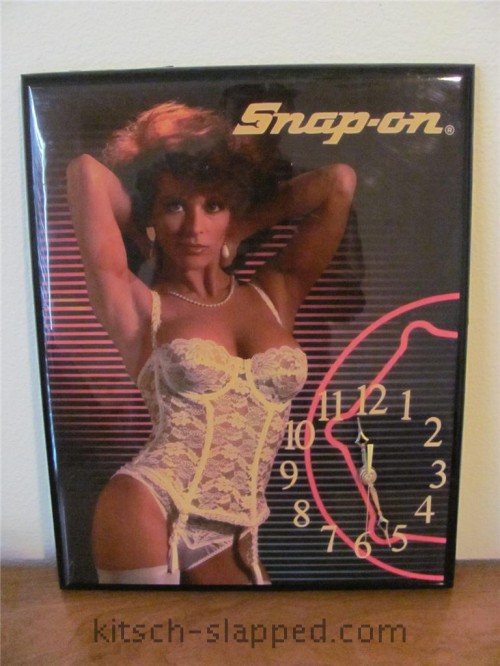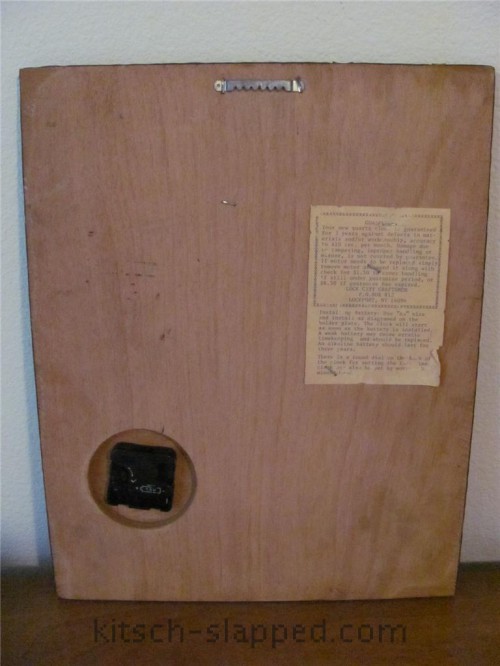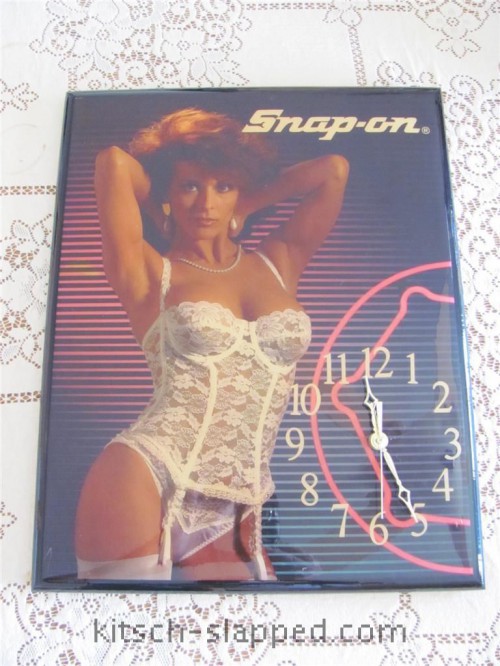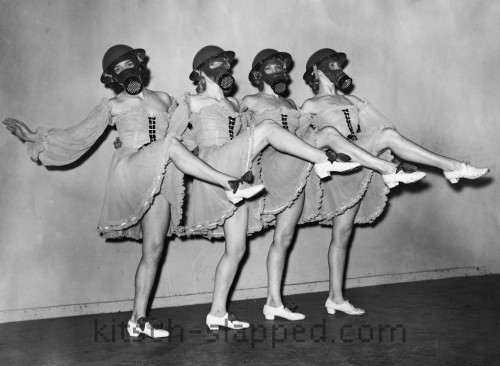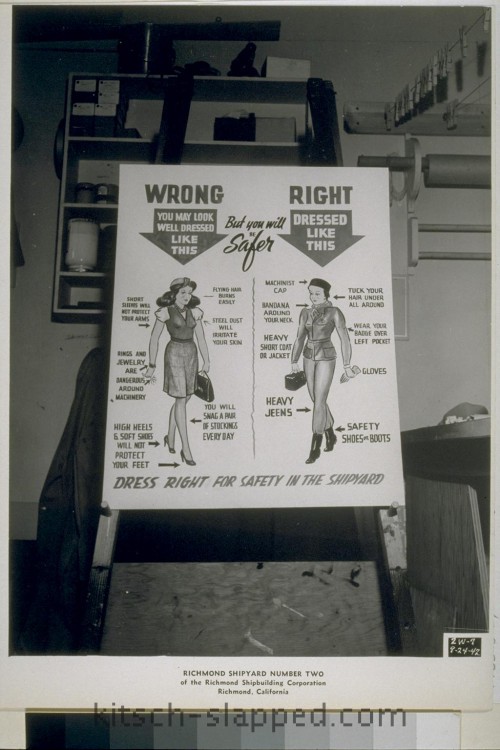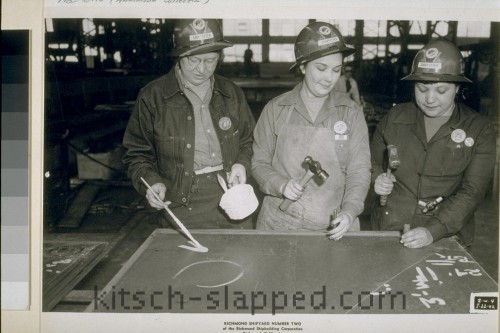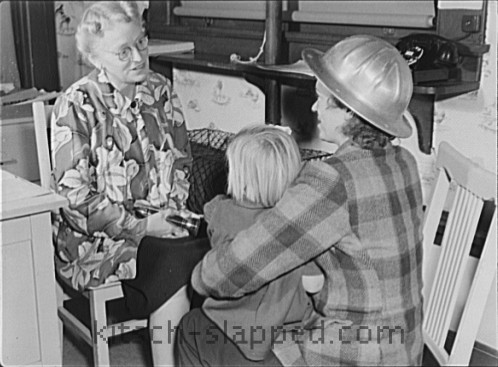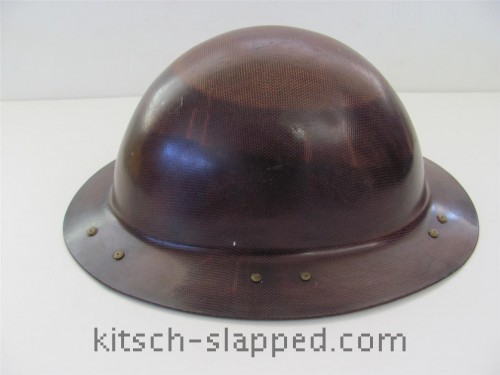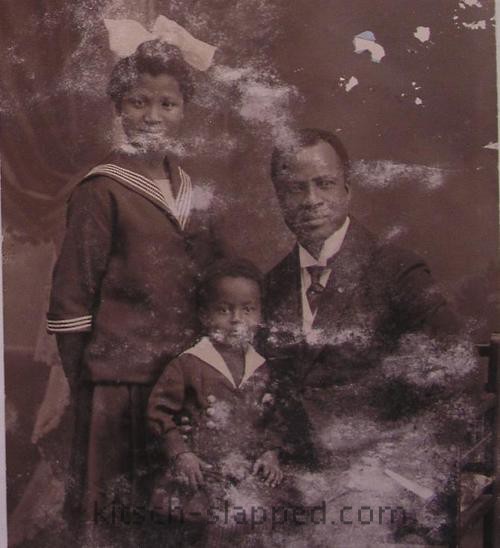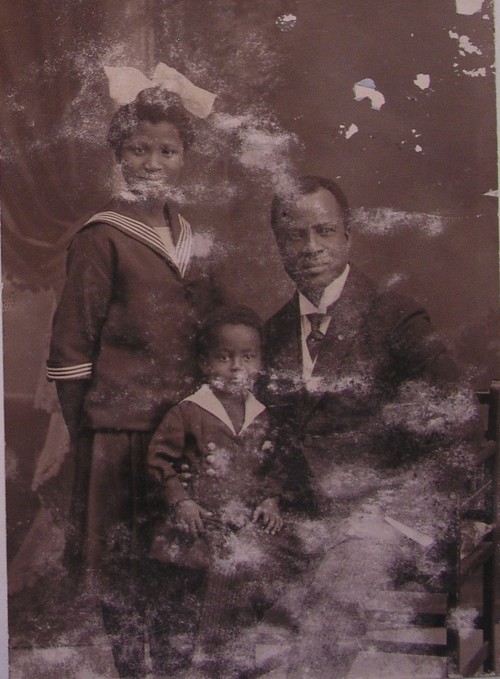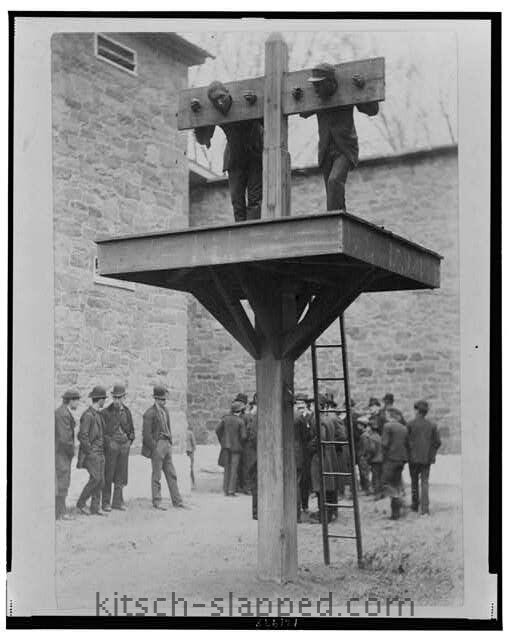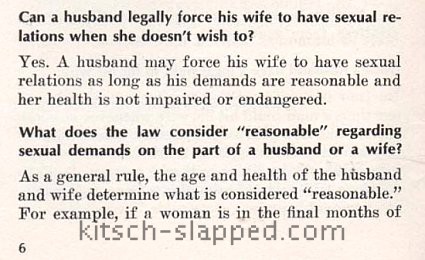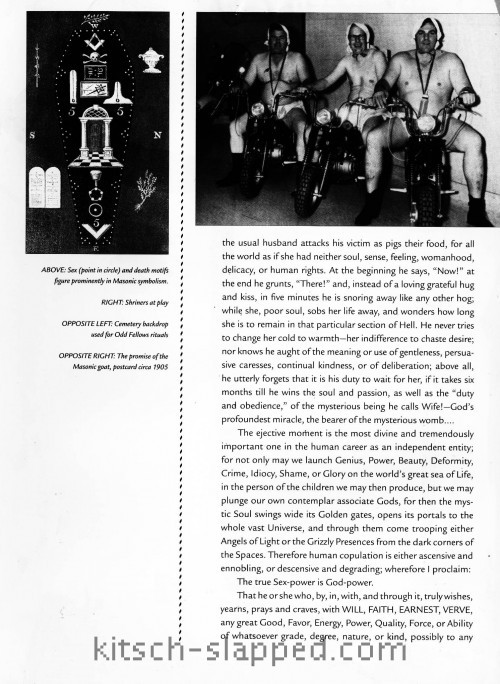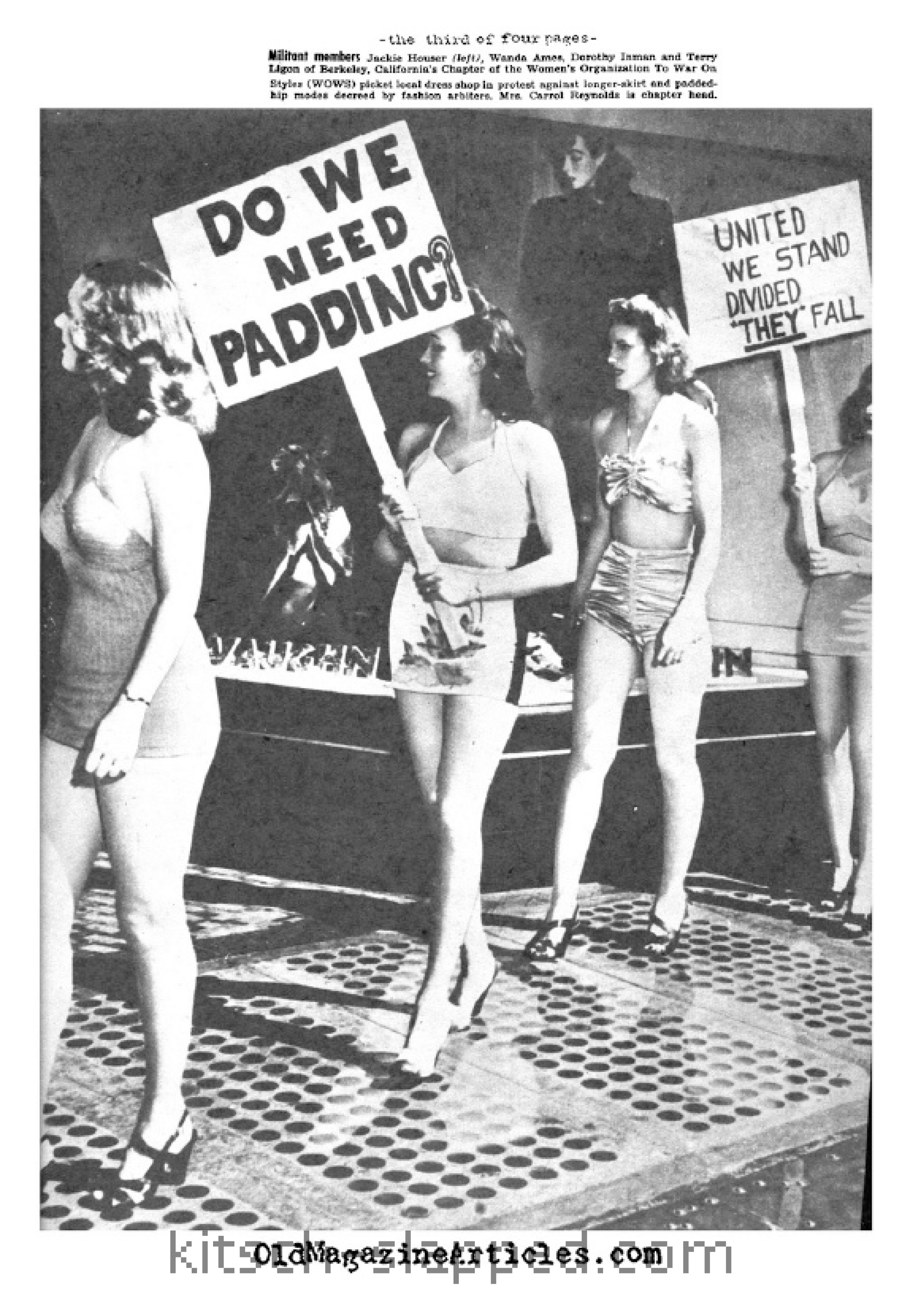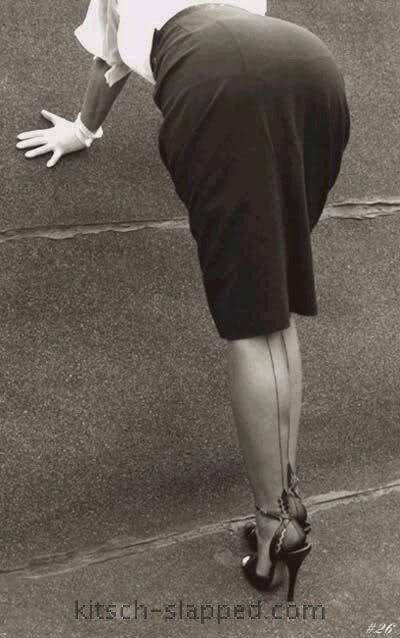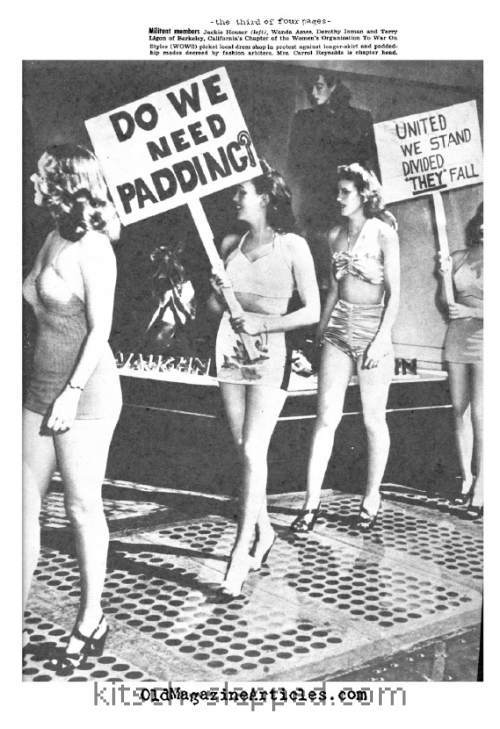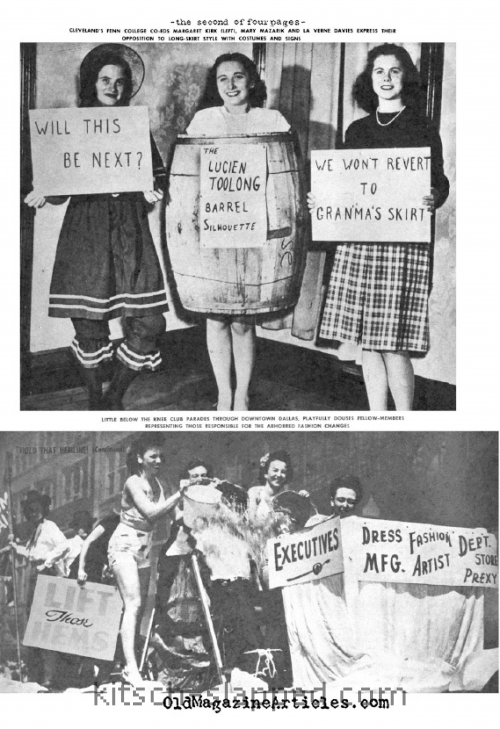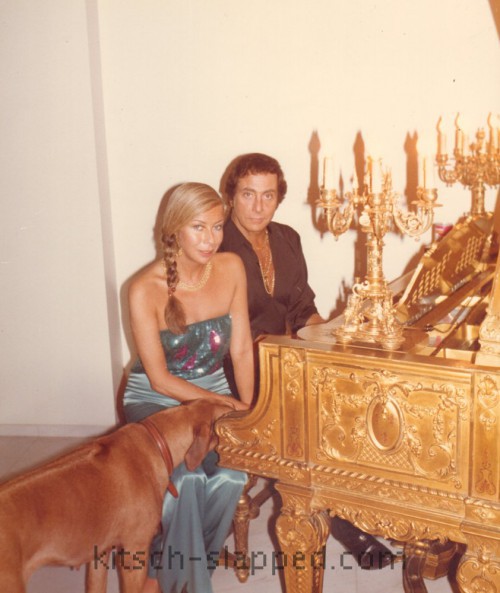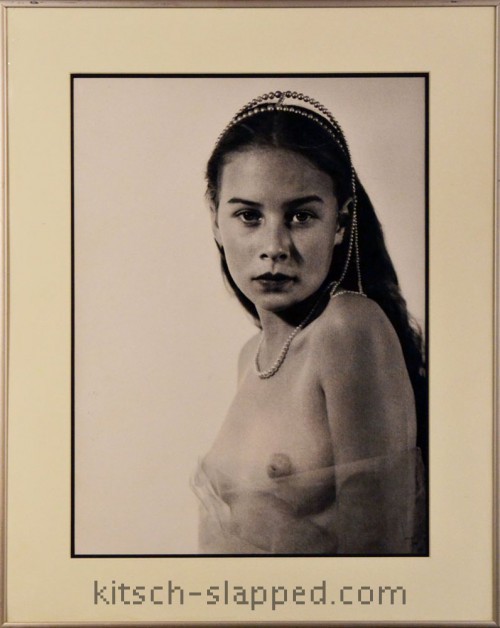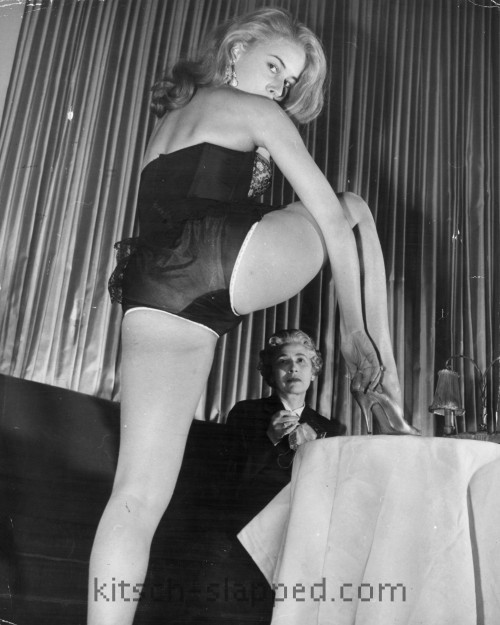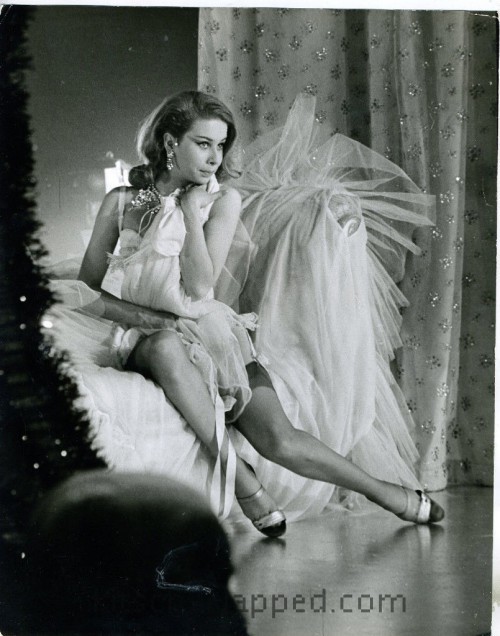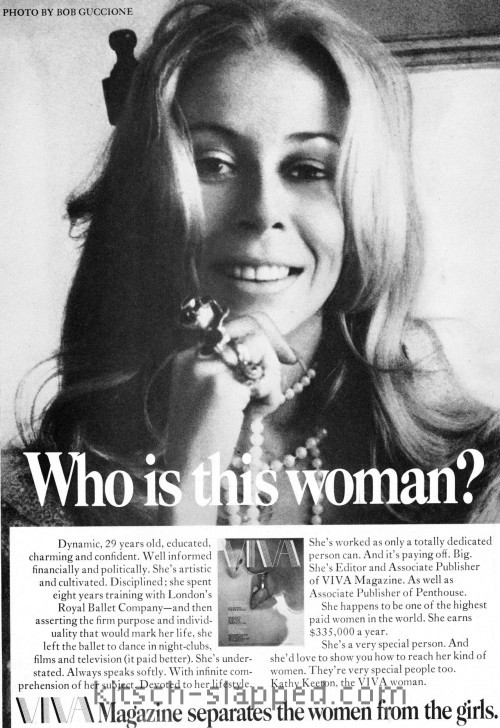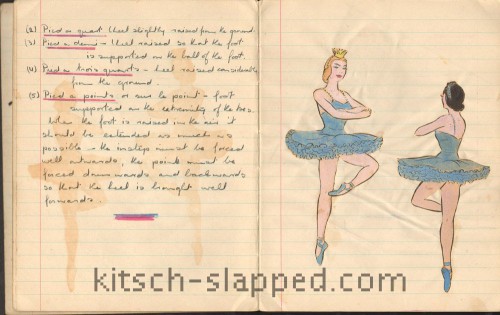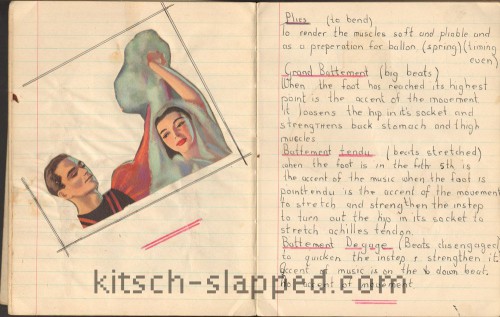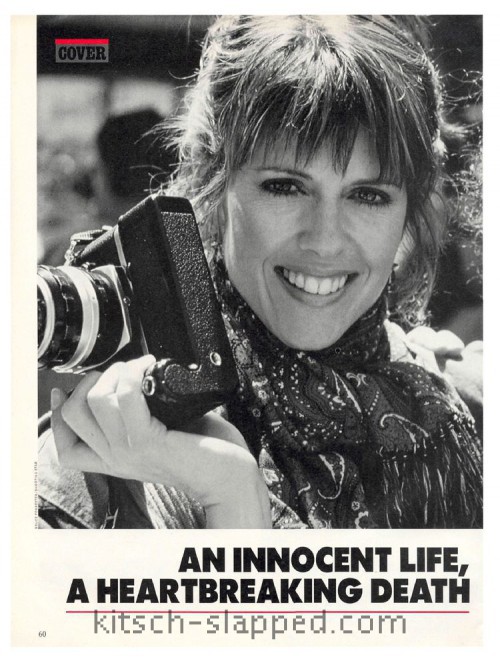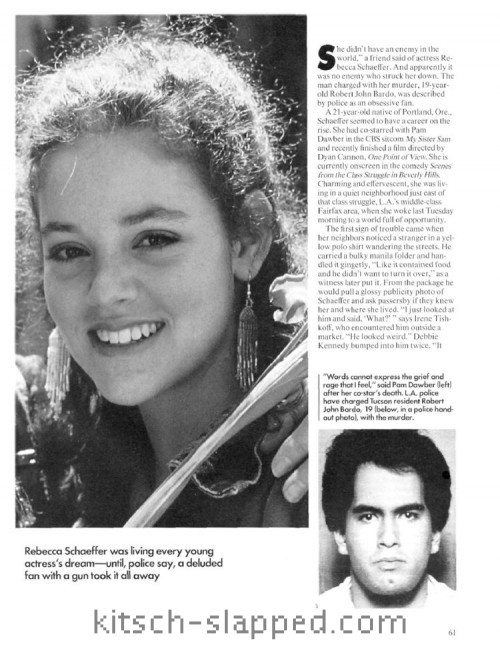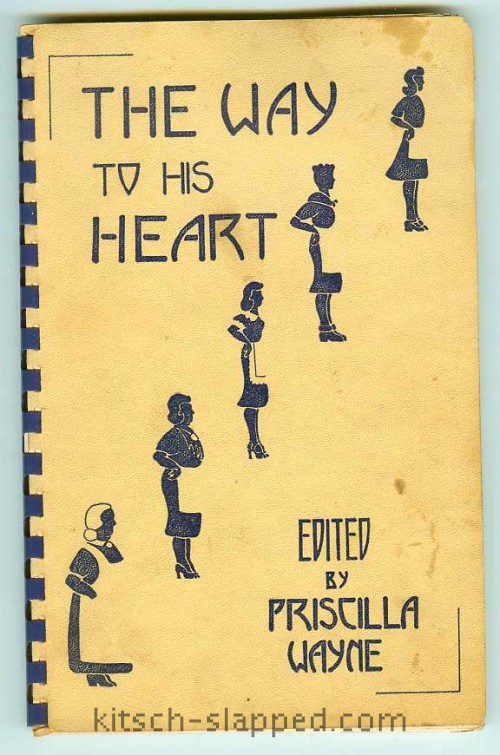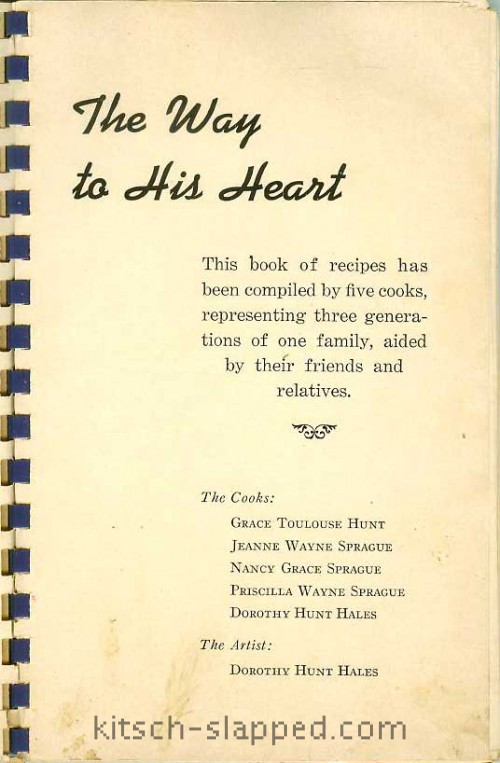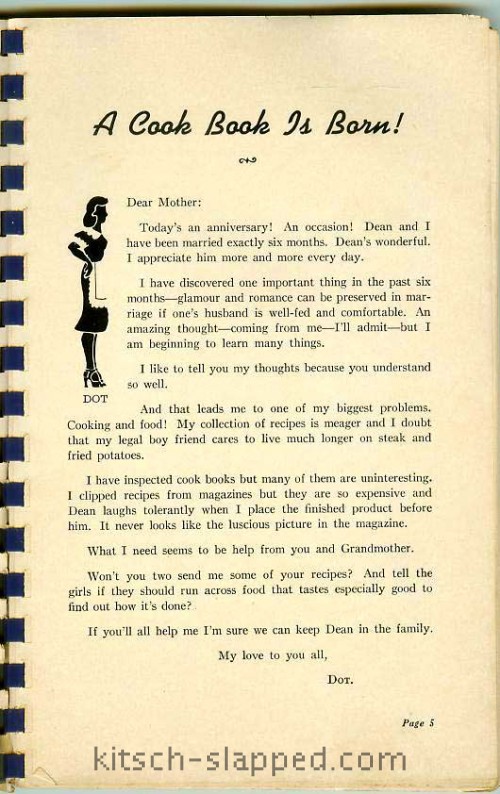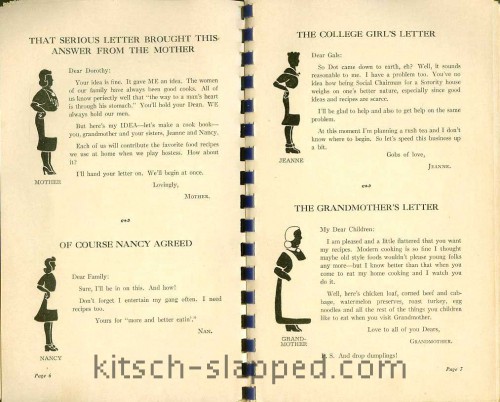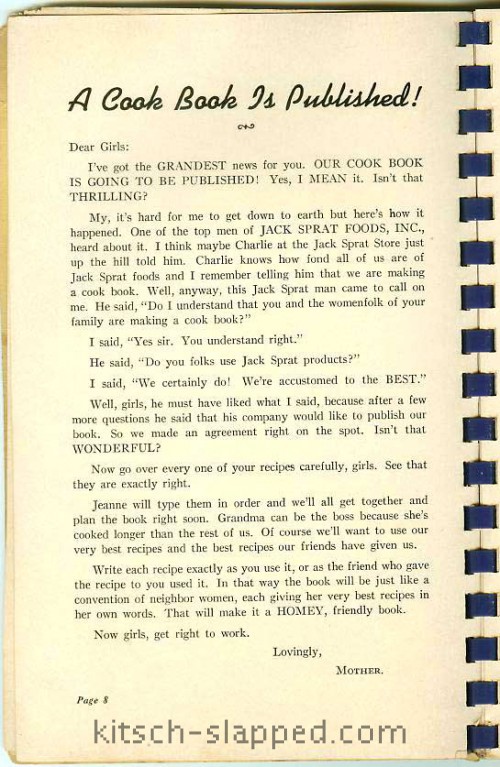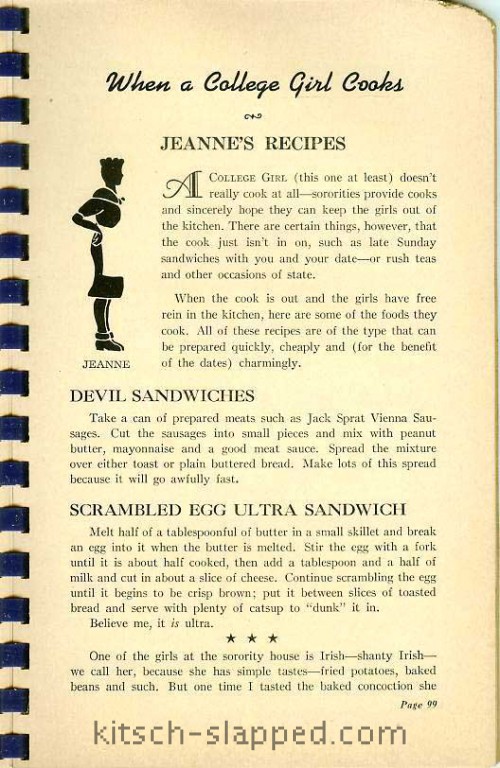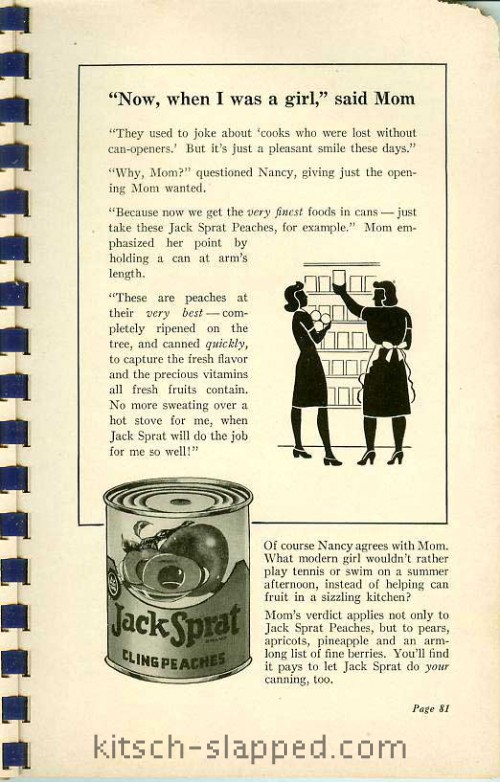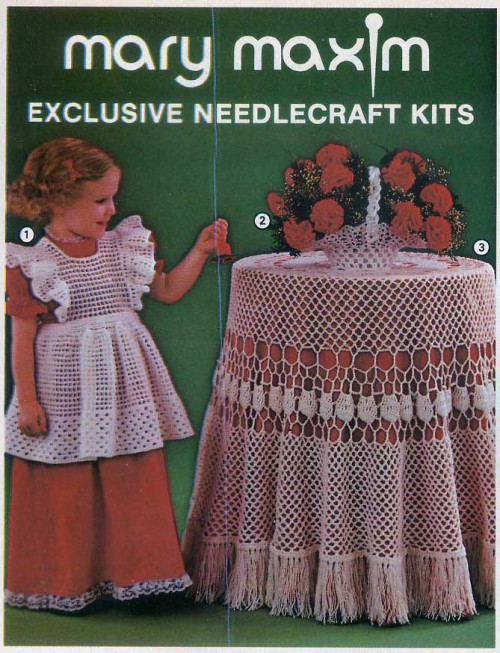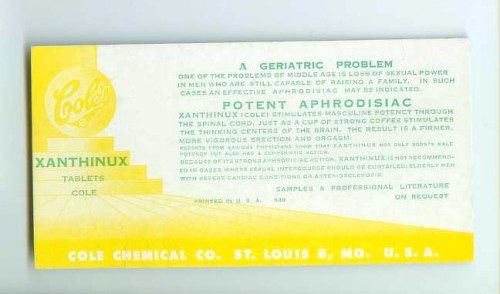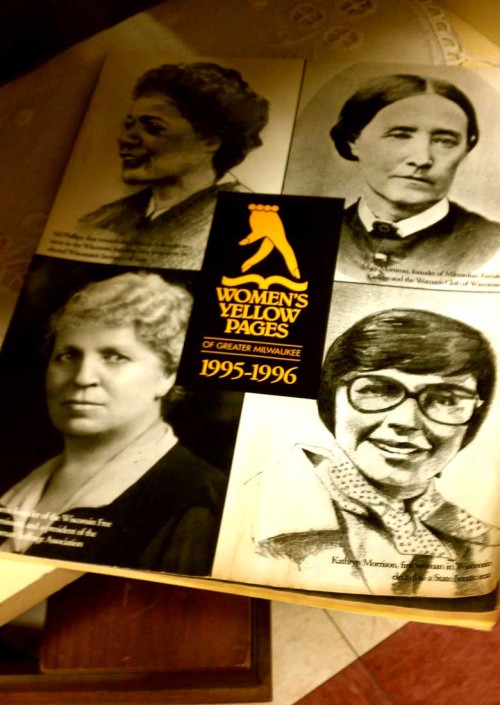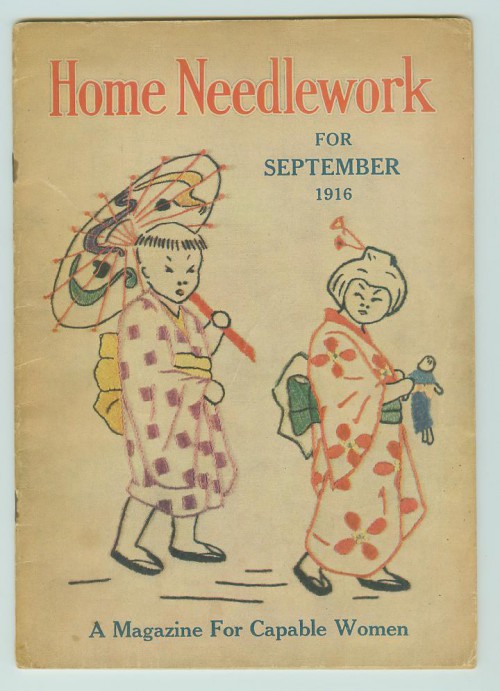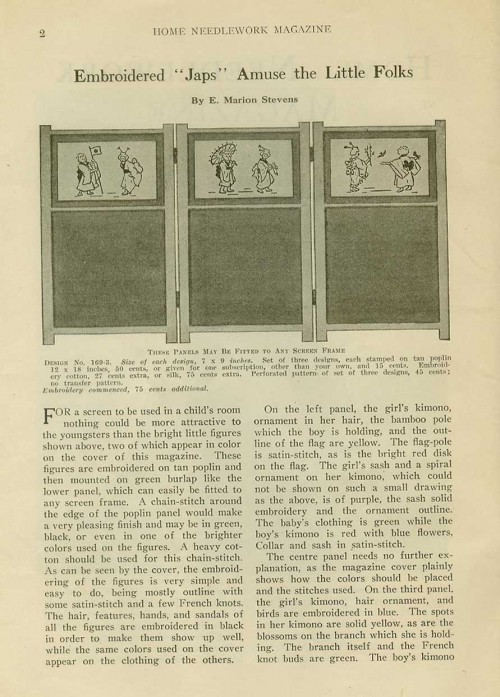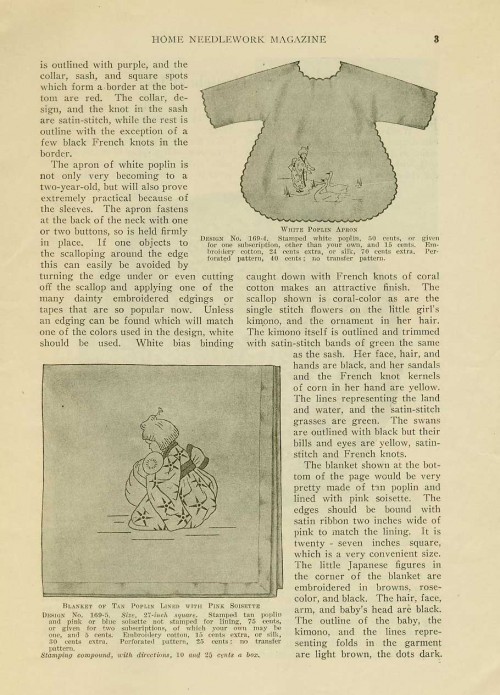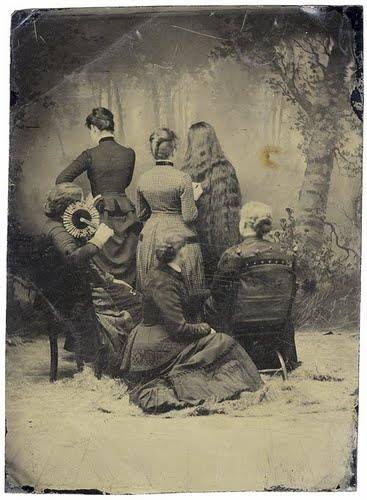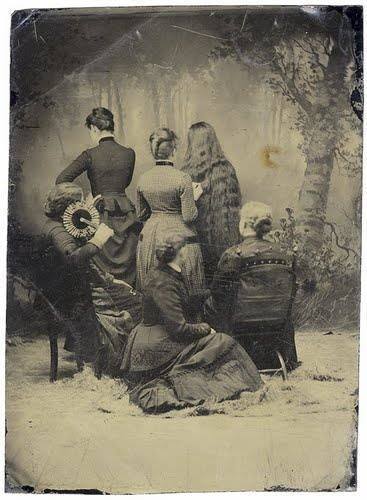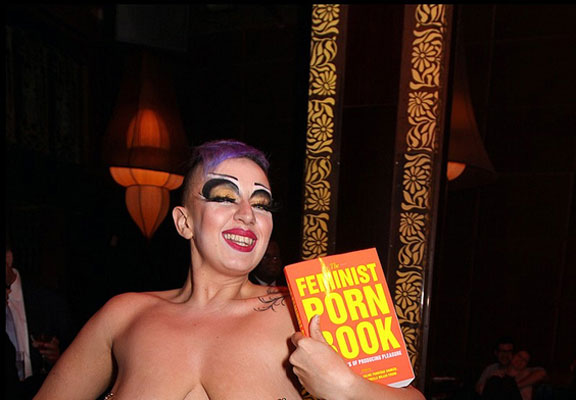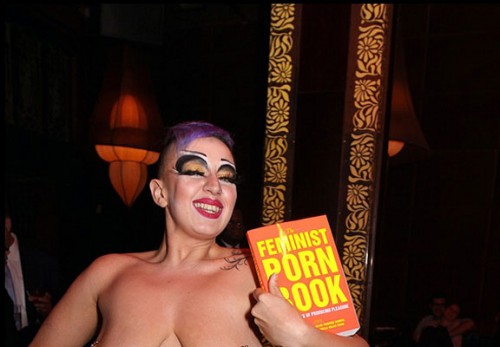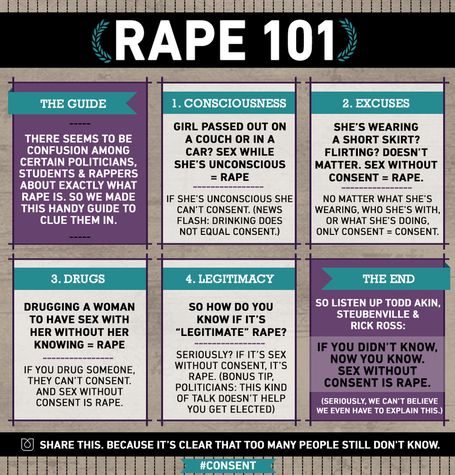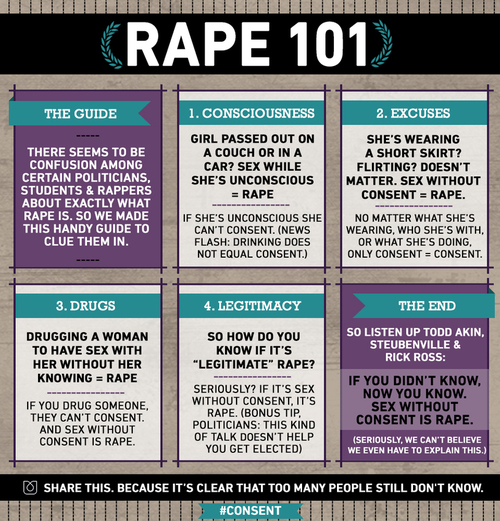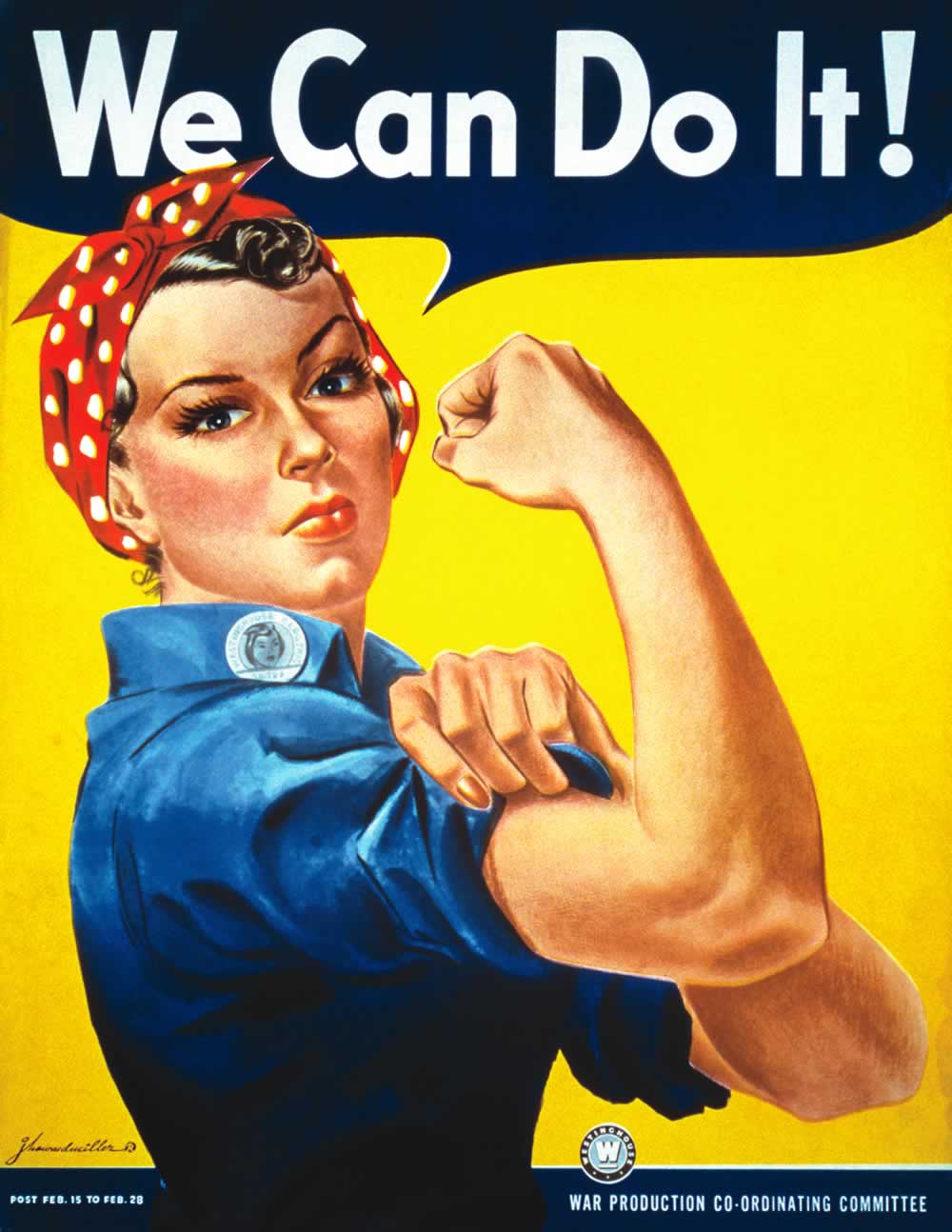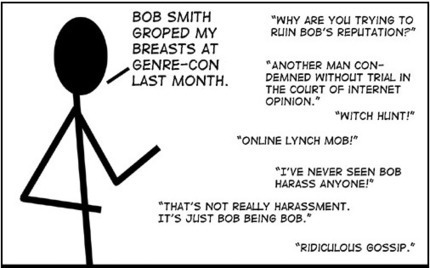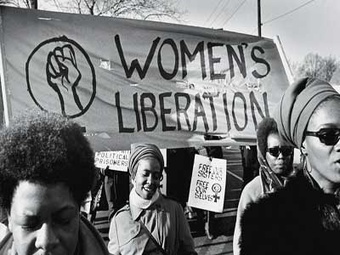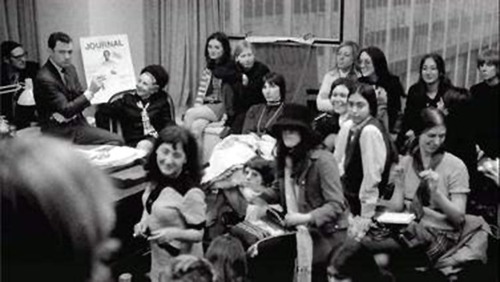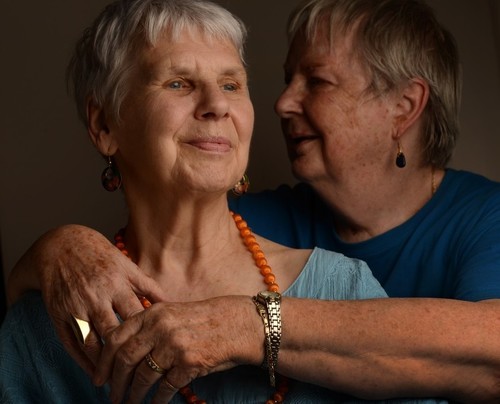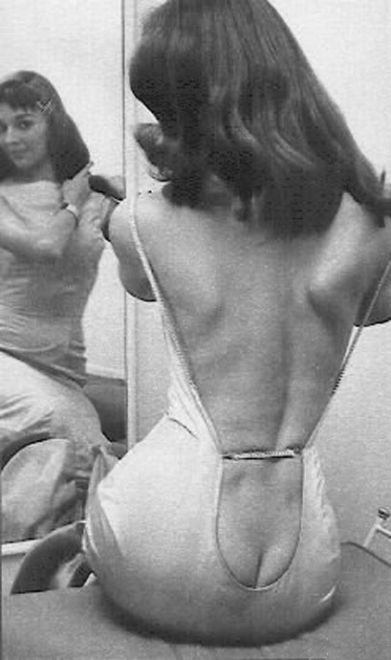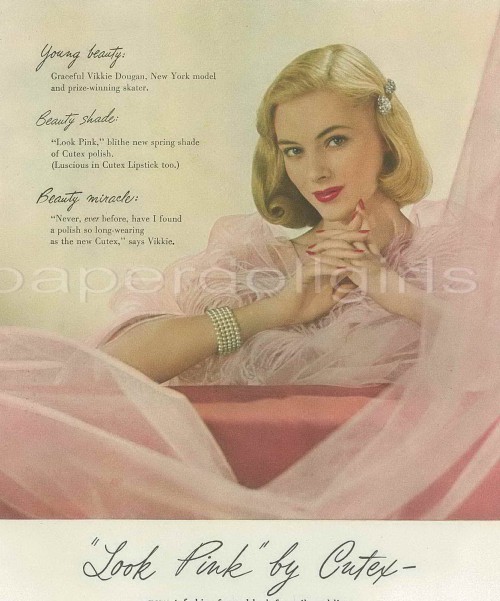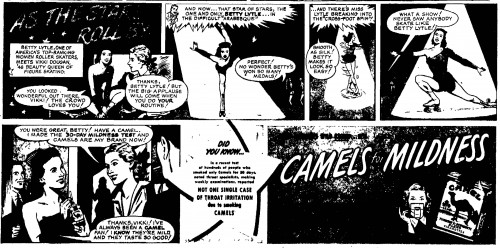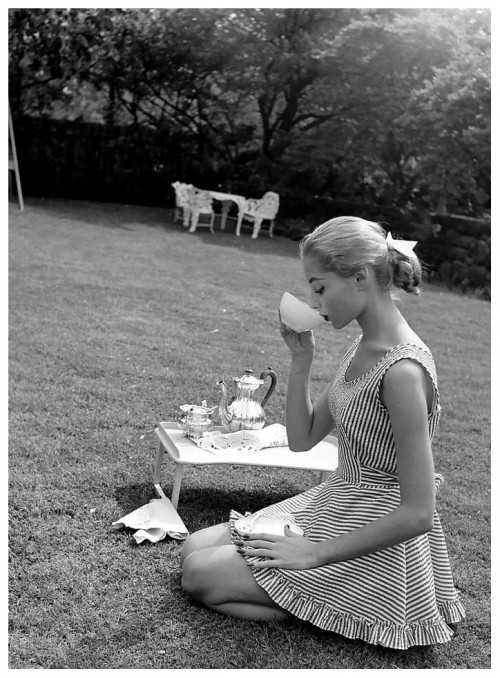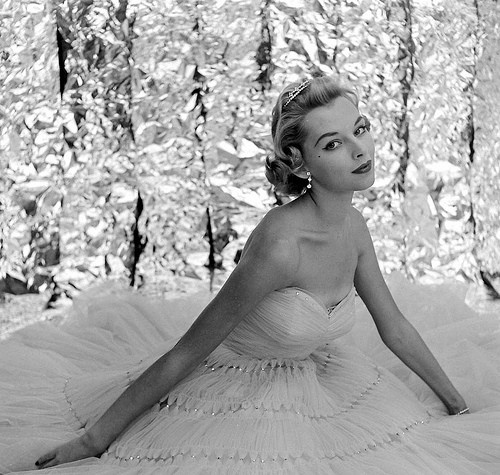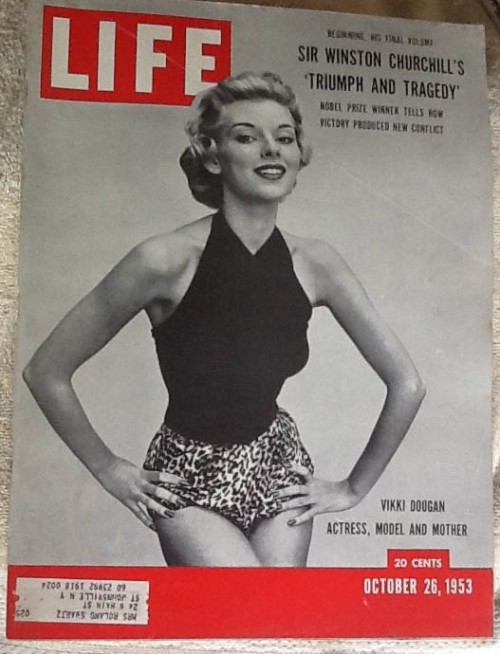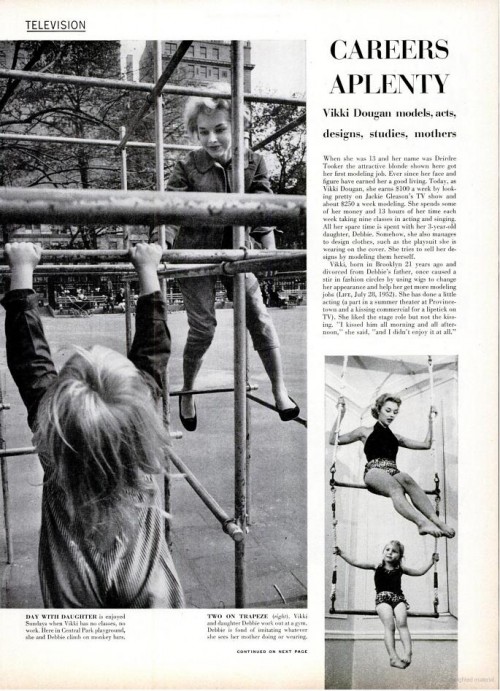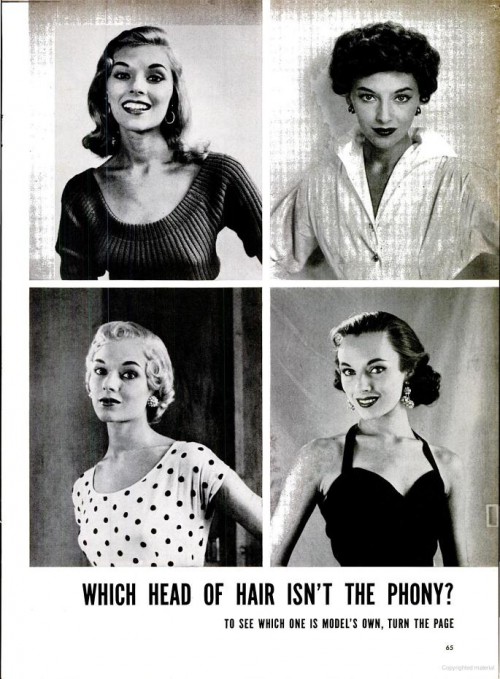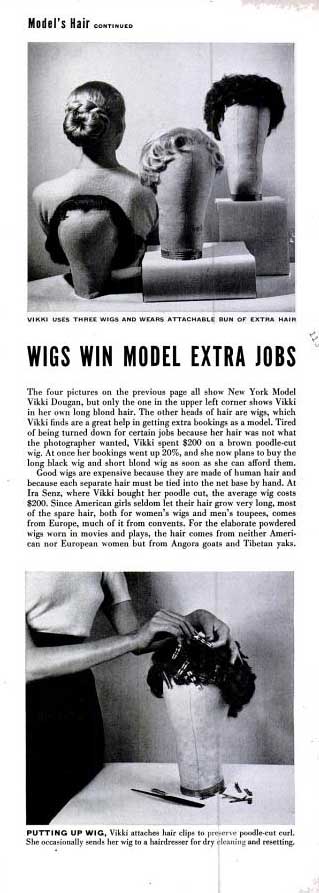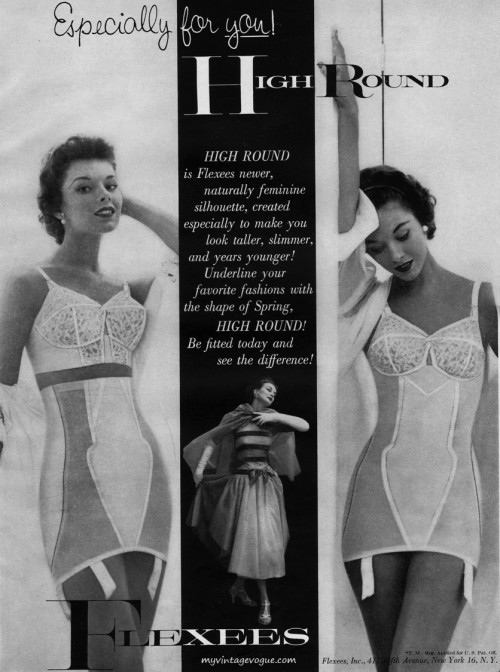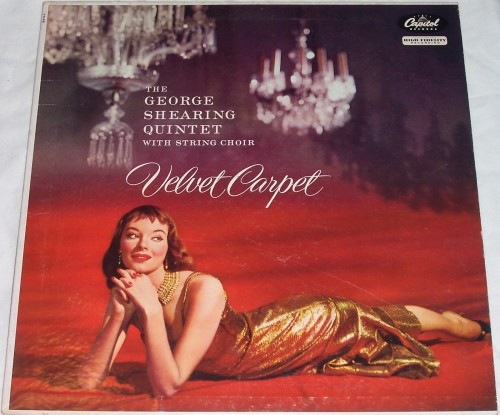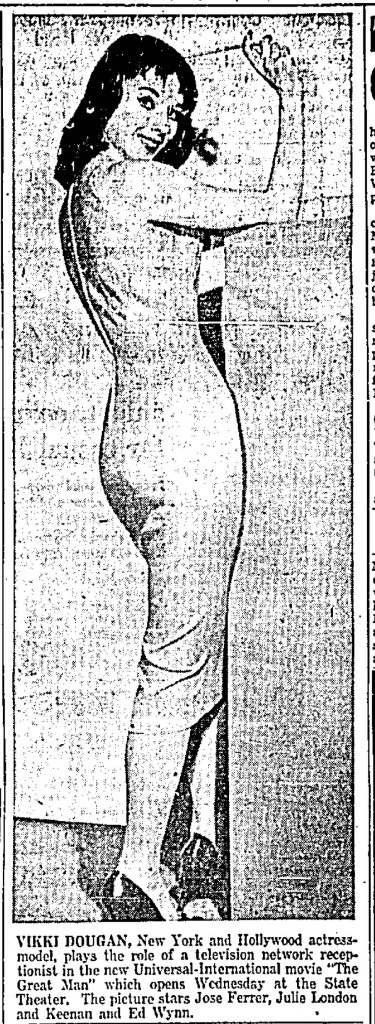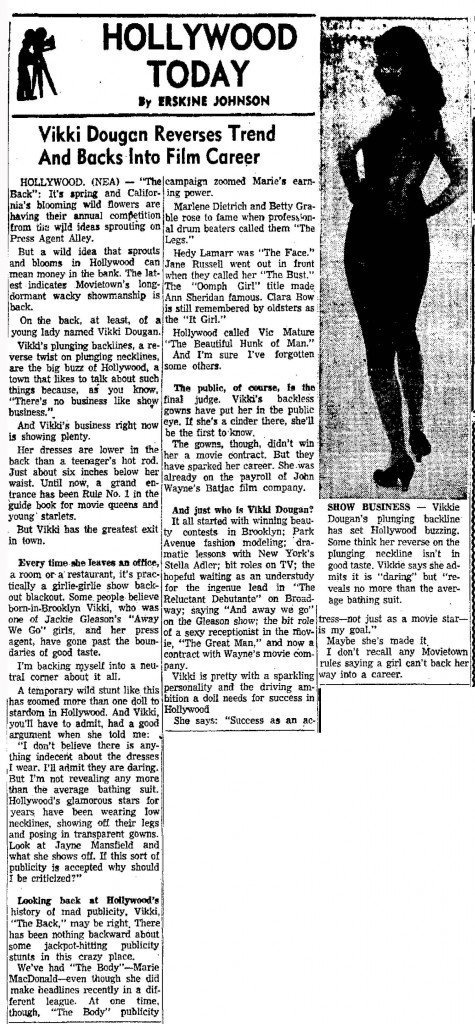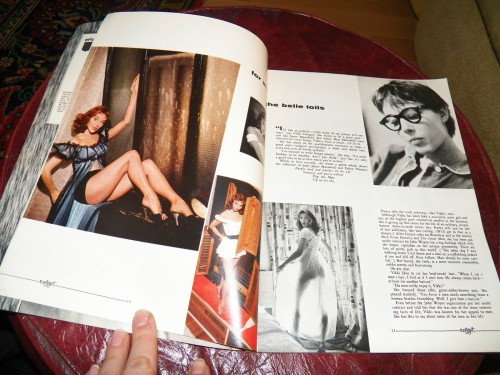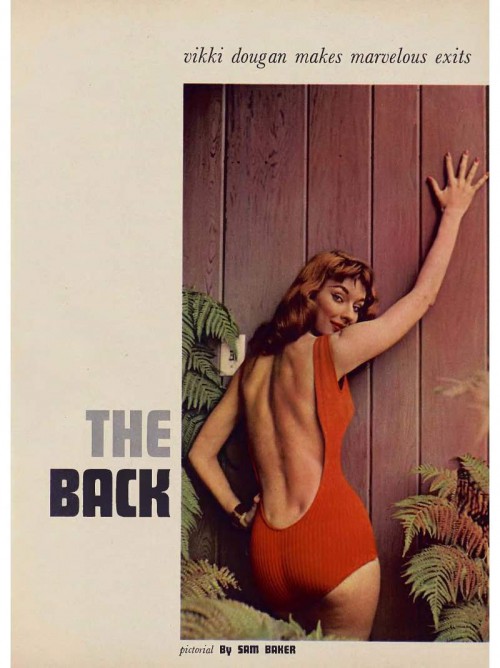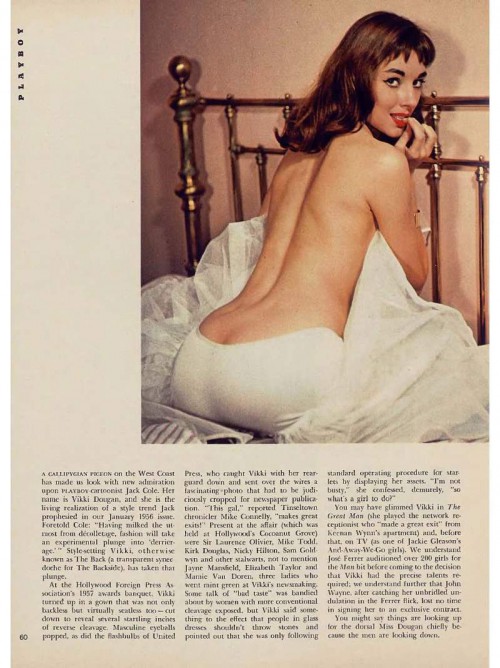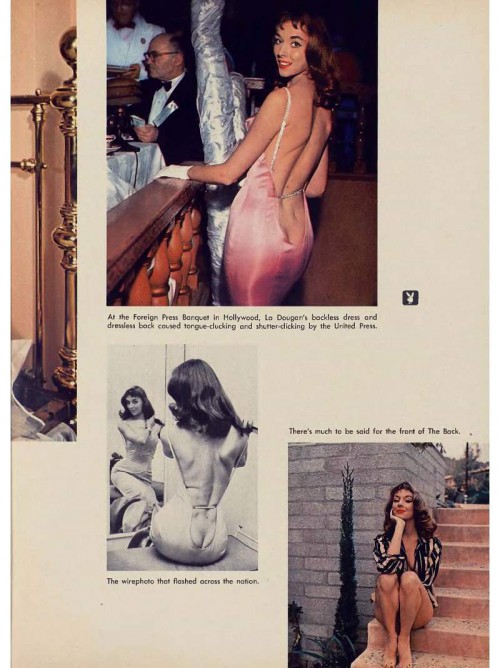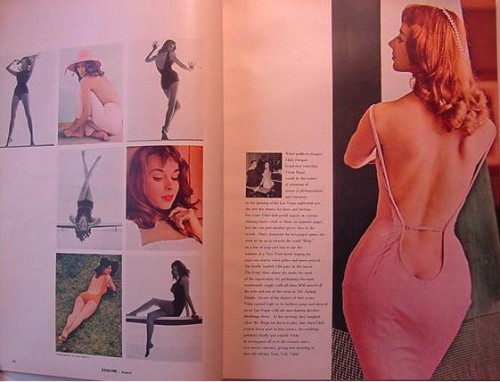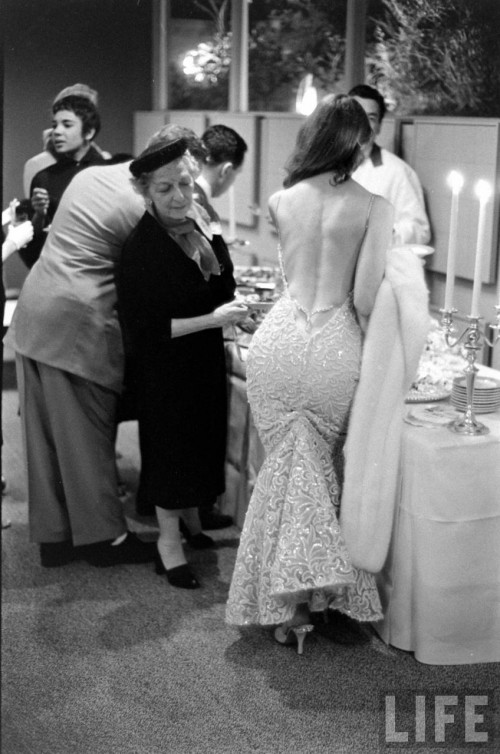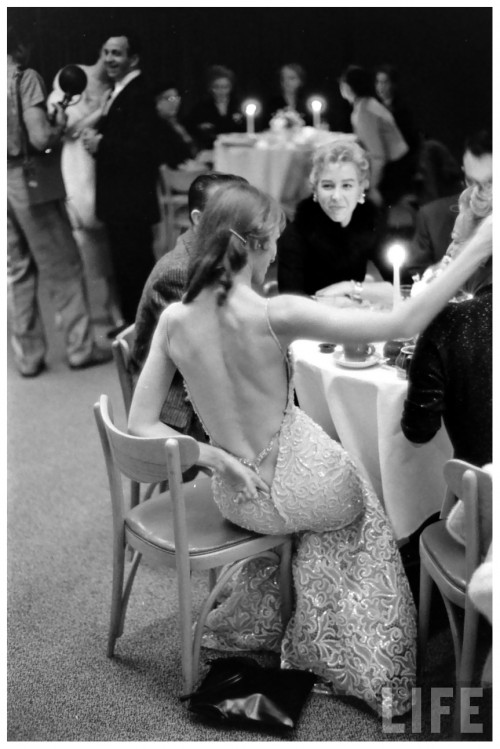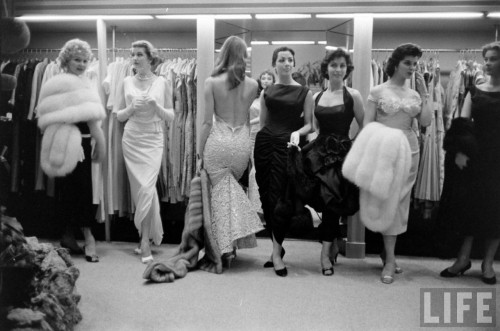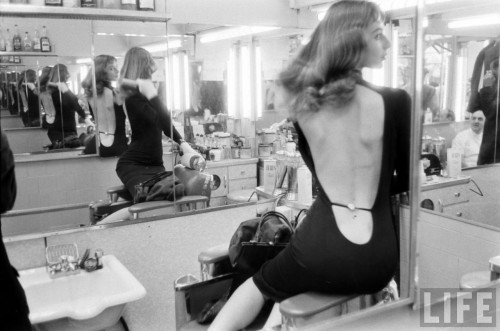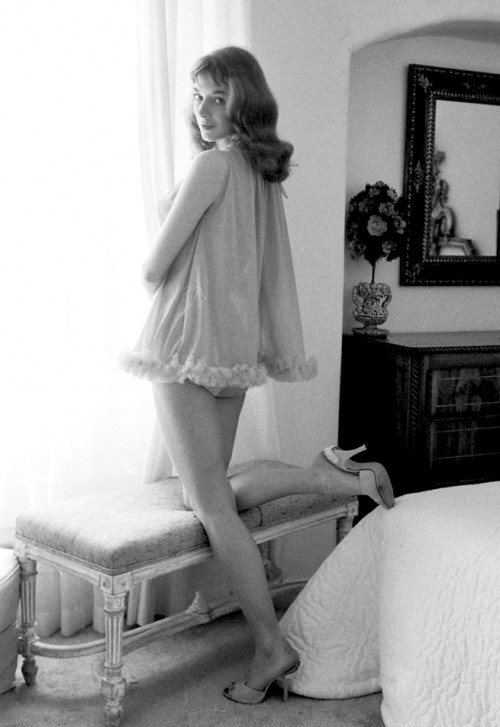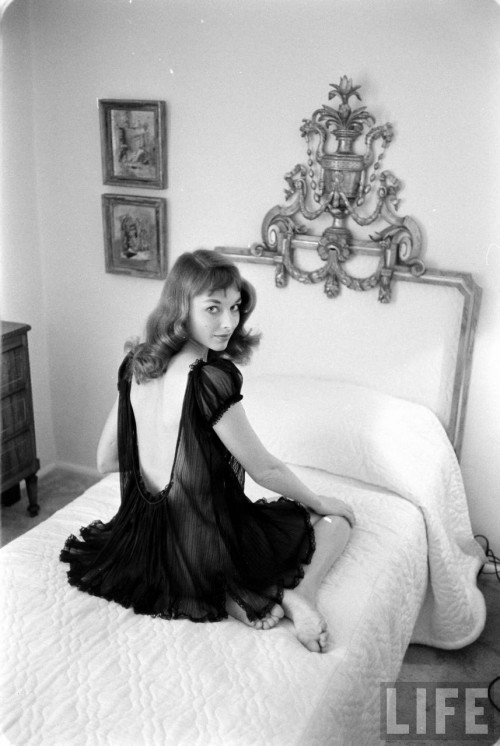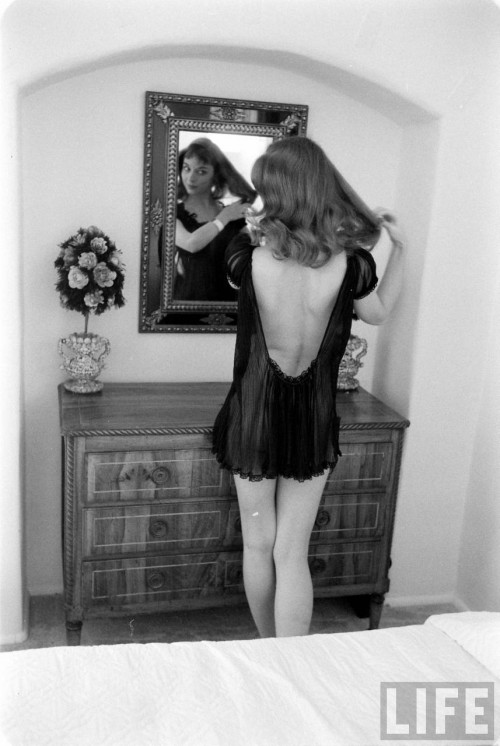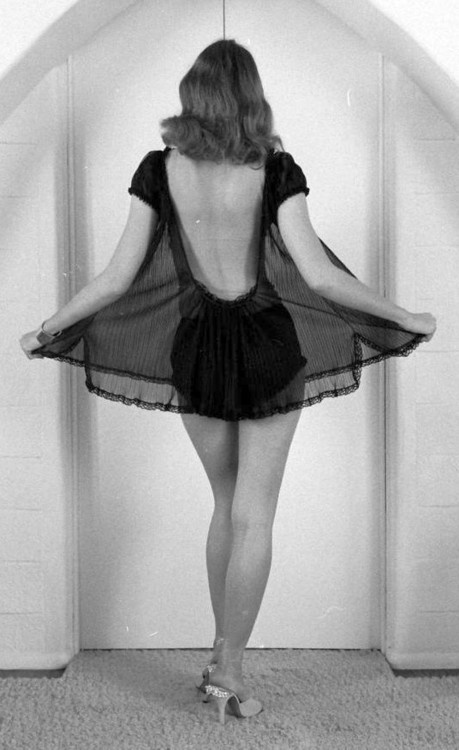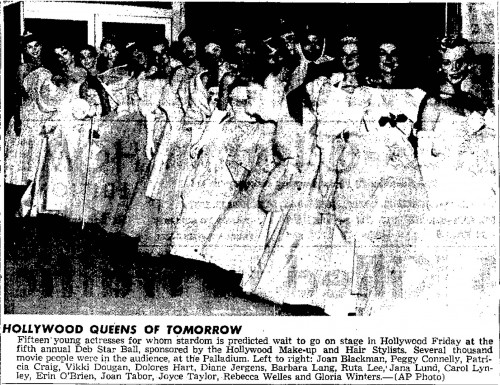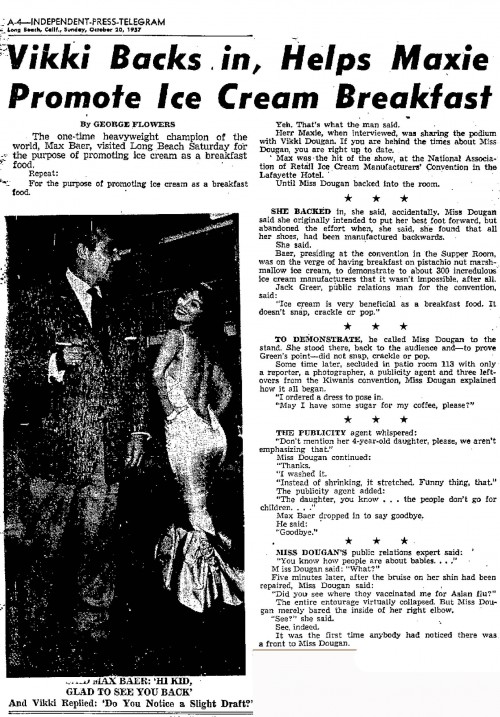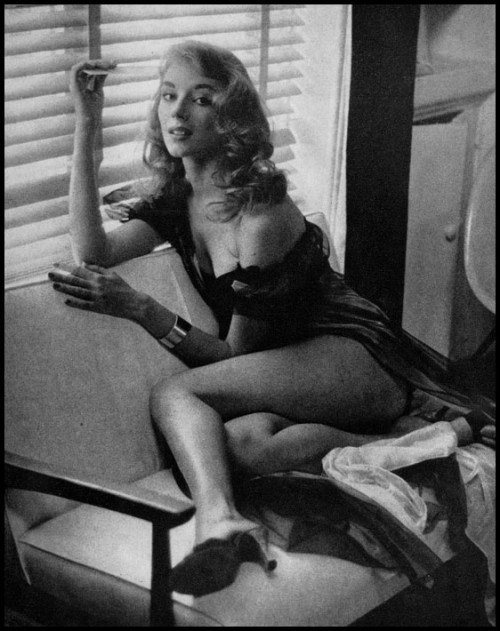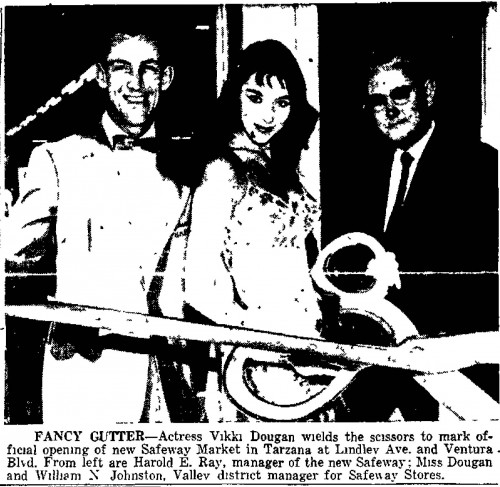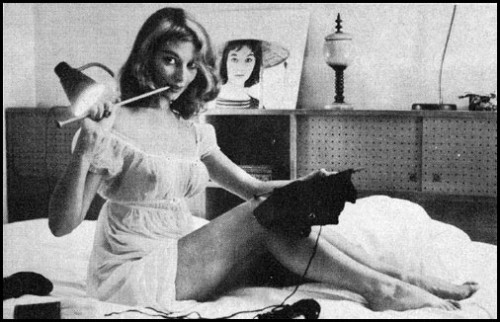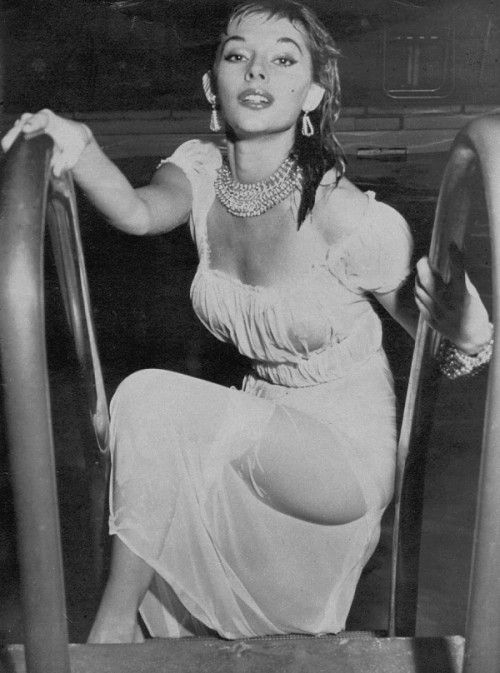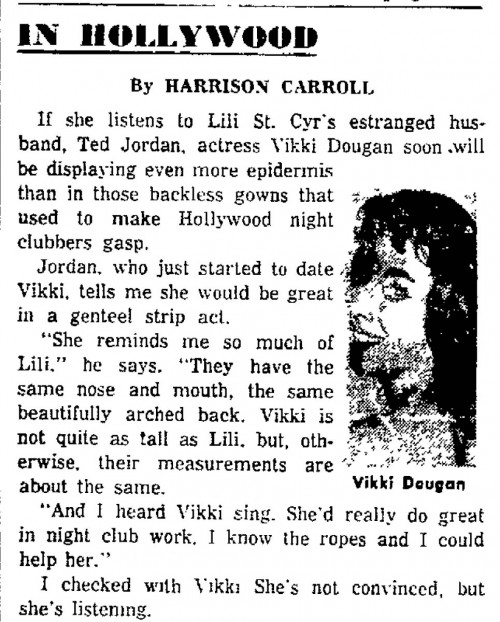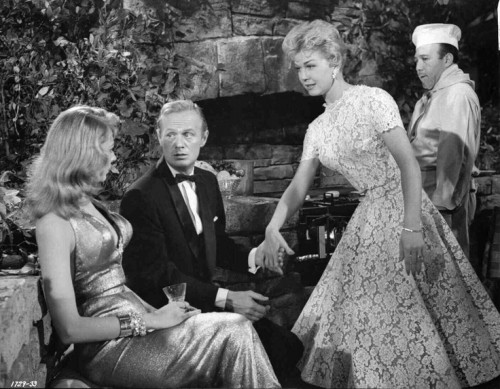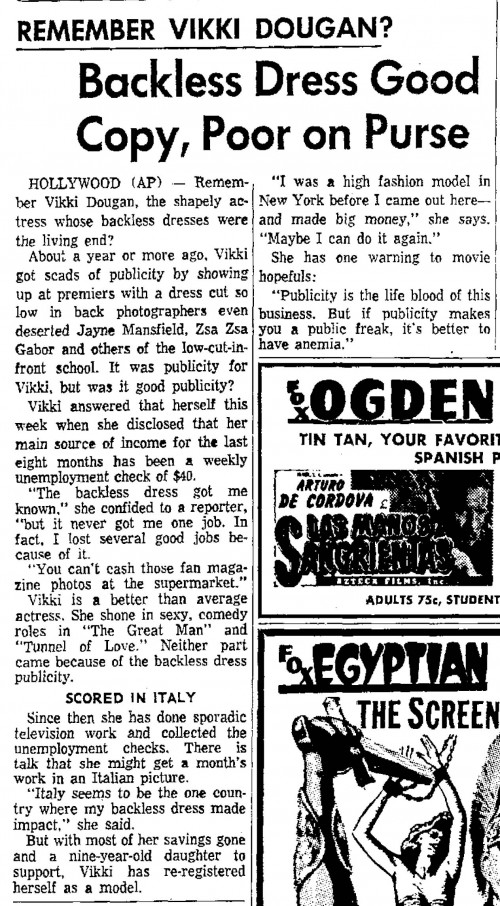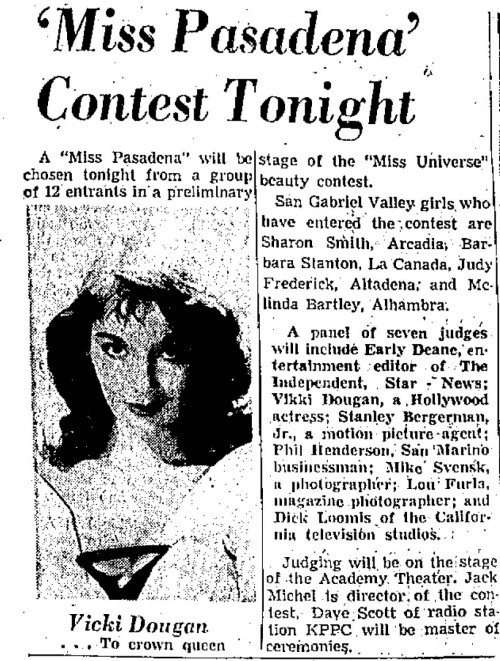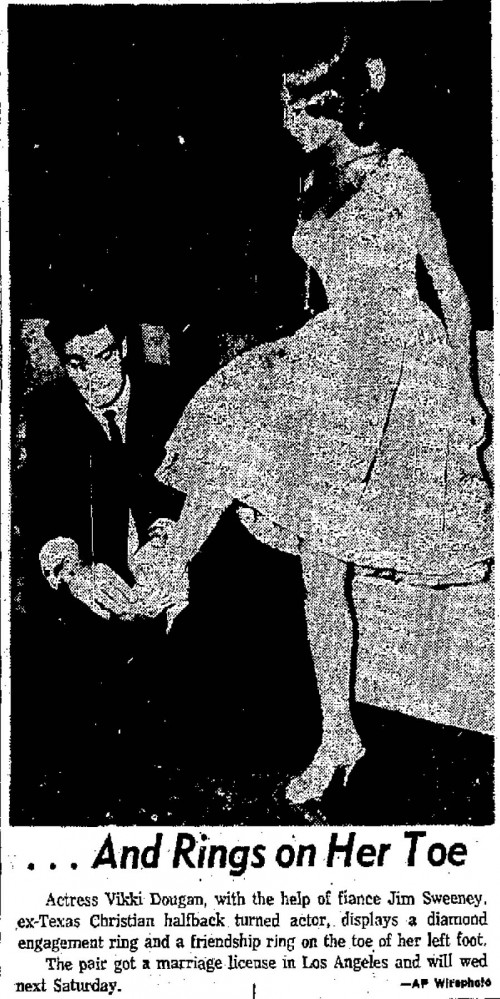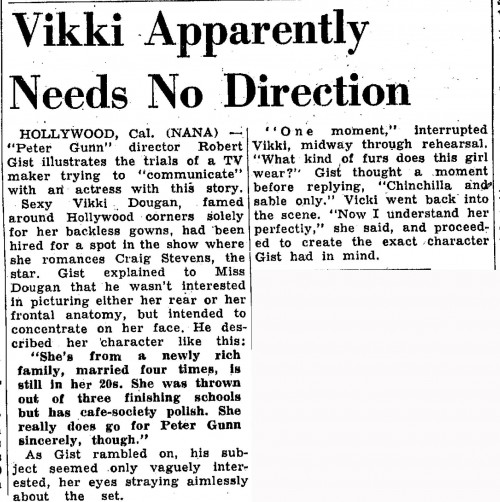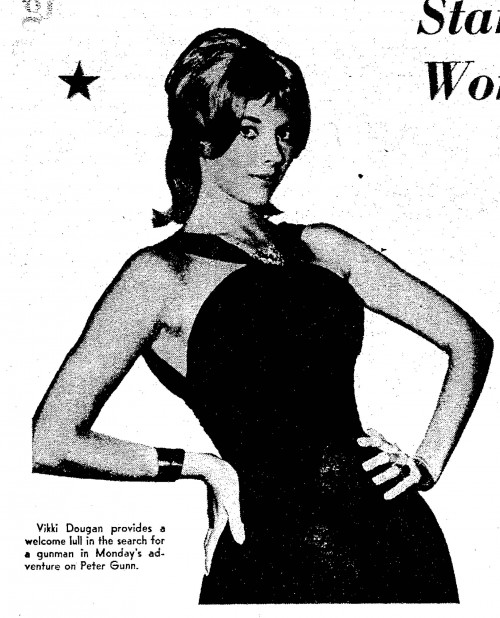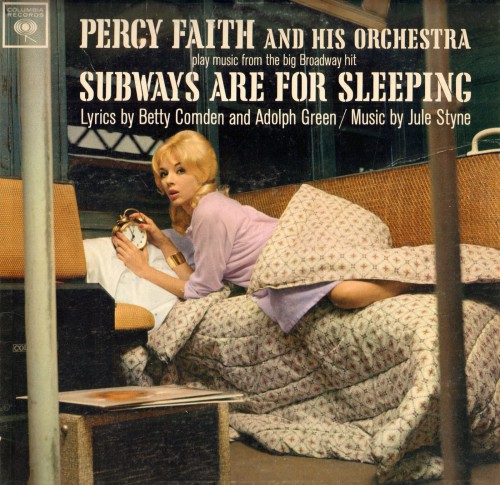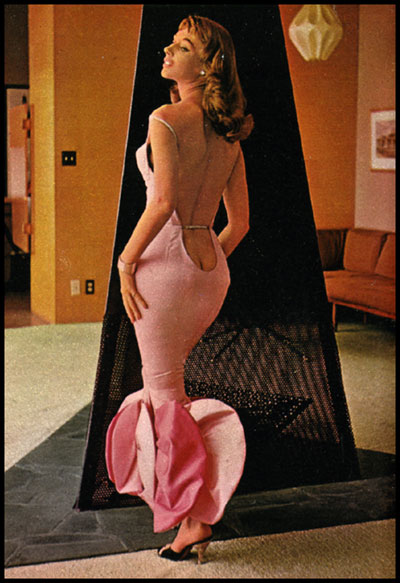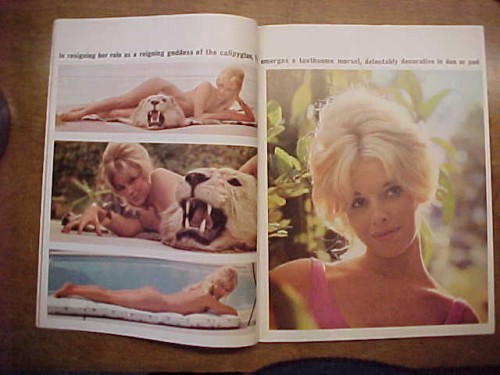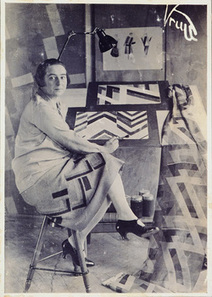It wasn’t that long ago that companies provided calendars and other promotional items featuring scantily-clad and even nude women to their clients. This is a classic example of one of those advertising pieces from the 1980s: a lingerie wearing lady on the glossy surface of a clock promoting Snap-On Tools. (See also: Vintage Risque Pin Up Calendars.)
Tag: culture
Of Hard Hats In Hard Times
Normally, we see the pin-up version of women working in WWII. Like this image of dancers at London’s Windmill Theatre practicing their routine while wearing gas masks and hard-hats with their costumes. (January, 1940.) Or we find articles focusing more on the figures of women, in service or not.
But hard hats were more than de rigueur for cute images of women on the homefront during those war years. In fact, there were many promotional campaigns advising women on how to dress for their new world of physical labor and factory work. This one didn’t emphasize hard hats; but clearly the focus is safely, not being fashionable.
Here’s another image from the Henry J. Kaiser Pictorial Collection showing female employes working at the Richmond Shipyard wearing their hardhats.
Here’s another bit of history:
Mrs. Arlene Corbin (right), time checker in a Richmond, California shipyard brings two-and-a-half-year-old Arlene to a nursery school every morning before going home to sleep. Mrs. Corbin works on the midnight to 7:30 a.m. shift and relies upon the school to keep her daughter busy and happy during the day.
If you collect actual historical objects of women from WWII, check out this vintage wartime fiberglass safety hat.
The hardhat belonged to a female employee who worked for Kaiser Steel in Fontana, CA during 1942-45. It may be more difficult to appear beautiful in a hardhat (even Rosie the Riveter’s bandana is pretty rockin’), but hard hats were the realities in hard times like war. And hats like this are a part of women’s history that shouldn’t be shunned for the pretty pinup version.
An African Princess Who Stood Unafraid Among Nazis
Between 1939 and 1946, Fatima Massaquoi penned one of the earliest known autobiographies by an African woman. But few outside of Liberian circles were aware of it until this week, when Palgrave McMillian published The Autobiography of an African Princess, edited by two historians and the author’s daughter. The book…
An amazing story!
Just added the book to my wishlist; here’s the Amazon link: http://www.amazon.com/gp/product/0230609589/ref=as_li_ss_tl?ie=UTF8&camp=1789&creative=390957&creativeASIN=0230609589&linkCode=as2&tag=glamkitllc-20
See on www.theroot.com
Context Is Credibility
I’ve written before about the importance of context; and ranted too about “stolen” images used, uncredited etc., at Tumblr and other sites. I’ve tweeted and posted at Facebook about my hatred of such things. Others have taken a far more direct and pointed-tongued approach (NWS) regarding the issue. But Sarah Werner‘s It’s History, Not A Viral Feed is the most direct and well-articulated article — complete with excellent resources.
Men being punished for "Posting Pictures Without Proper Attribution," date and source unknown. pic.twitter.com/A2vOILcvFL
— A. History (@AhistoricalPics) January 24, 2014
— A. History (@AhistoricalPics) January 24, 2014
Surviving The Night Of A Thousand Vaginas
I was thrilled to see that Martha Plimpton wore her scarlet letter when she was on Craig Ferguson last week (23 January, 2014).
http://youtu.be/3hlX7f8mE2U
Not only did Plimpton talk about her organization, A Is For, but she spoke about the recent fundraiser too. The event was called A Night of a Thousand Vaginas — no, not this Night Of A Thousand Vaginas. Though it’s pretty clear that too many Americans are as afraid of vaginas as the parody suggests; or at least, as Plimpton said, uncomfortable with the word.
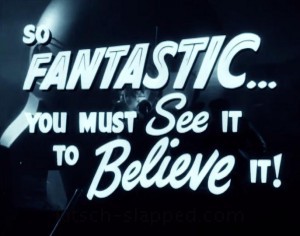 Anyway, the A Is For Night of a Thousand Vaginas event was to raise funds for the Whole Women’s Health Fund, Lilith Fund, Fund Texas Women, and TEA Fund. It had a great line-up of comedians & others and quickly sold out. Early reports estimated they raised $20,000. That’s the good news.
Anyway, the A Is For Night of a Thousand Vaginas event was to raise funds for the Whole Women’s Health Fund, Lilith Fund, Fund Texas Women, and TEA Fund. It had a great line-up of comedians & others and quickly sold out. Early reports estimated they raised $20,000. That’s the good news.
The bad news is that others came & demonstrated at the event, saying, “Sadly this was done in the name of ‘comedy.'” Normally I wouldn’t give these folks any attention or press, but it’s always educational to see what the other side is up to — and some of the comments are fascinating. Apparently we are to watch for a conversation also recorded that night between the evangelical Chaplain Bill and Sarah “the Blasphemer” Silverman, because Chaplain Bill sent that video to “a wonderful Christian based media organization” who may or may not opt to share it. I would like to see that myself — unedited, of course.
Since many of us couldn’t get tickets or even get to L.A., I was hoping there would be some video of the event; but no such luck. (We can keep an eye on A Is For’s video channel, just in case something shows up.) Meanwhile, you can still support the work of A Is For by donating and/or buying merch.
Image via.
Politicians: Erect & Standing Up, But Not For Women
Maybe you don’t want to call it a “war on women”. Maybe you find the word “war” to be over-the-top, despite the facts regarding bombings, shootings, rape, and other violent attacks against women, including the places where they seek access to medical care. Perhaps you just don’t think that violence is enough to be called a “war”. But what about when you factor in the legislative bombs aimed directly at women here in the USA?
Legislating against women’s rights is at the center of politics. In the past three years, state legislatures in the US have enacted a record-setting 205 restrictions on women’s reproductive rights. That exceeds the total number of such restrictions enacted during the entire previous decade — and that last decade was no small potatoes either. Between 2001 and 2010, states passed 189 abortion restrictions. (Data from a Guttmacher Institute report.)
Legislating against women’s rights is so popular right now, that one candidate for congress in Virginia, Richard Black, thinks that marital rape should be legal again, like it was in 1965, and that military rape is “as predictable as human nature”. That says a lot about his nature. And a lot more about a society in which someone espousing such beliefs can run for office.
Maybe 1965 isn’t so far back that we need a stone tablet to mark the date, but we sure are moving backwards.
And all this while, from 2006 to 2011, Medicaid was paying $175 million for 473,620 claims for penis pumps — you know, so men can have sex. Sex that maybe their spouses didn’t want to have. Sex that maybe resulted in unwanted pregnancies, because, you know, birth control isn’t always an option. It’s a limited option with many private insurance companies and with Medicare. And it’s even less likely that your insurance or Medicare will cover an abortion. But let’s just be glad that men not only have the right to those erections but the access to medical help to force those erections too. Isn’t it nice to know that men are all about standing up for themselves?
Servant of God, or Prostitute?
The Devadasi, a centuries-old caste of sacred temple priestesses, struggles to have it’s own renaissance. One woman leads the way…
The origins of the practice are often disputed, but historians agree that in India by the 10th century this caste of sacred temple servants enjoyed great wealth & property as signs of respect & clout.
Considered married to the Hindu deities, the Devadasi were talented dancers, singers & even viewed as political advisors. At the core of Devadasi faith is the belief all men are incarnations of the male deities & so in addition to performing sacred temple ceremonies, Devadasis offered sexual services. In the act of making love, a man & a Devadasi enact the sacred marriage of god & goddess which therefore allows them to become divine themselves.
See on www.sex-kitten.net
19th Century Sex Magic Is Sex Positive
At the Picture Collection and Periodicals Collection at the Visual Arts Library blog, a post featuring some materials from a “Gangs, Cults & The Occult” folder. Among the most interesting to me (at least at the moment), was this one:
Below the “Shriners at play”, there is an intriguing passage from what appears to be a work by Paschal Beverly Randolph. Randolph was, among other things, a medical doctor, occultist, and writer who is often noted as the man to bring the principles of sex magic to North America. Since this about secret societies, Randolph is also said to have established the earliest known Rosicrucian order in the United States and to been a member of the Hermetic Brotherhood of Light. But it is the sex magic which seems to stand out here. If this is by Randolph, the full passage, circa mid-1800s, would then read:
The average husband’s wife is full of aches, pains, wrinkles, gray hair, fallen womb, [lencorrhae]; and a good many of them are nicely inoculated with syphilis by their lords, and the doctors hide it, and their ignorance too, and call it “Fluor Albus;” besides which, the usual husband attacks his victim as pigs their food, for all the world as if she had neither soul, sense, feeling, womanhood, delicacy, or human rights. At the beginning he says, “Now!” at the end he grunts, “There!” and, instead of a loving, grateful hug and kiss, in five minutes he is snoring away like any other hog; while she, poor soul, sobs her life away, and wonders how long she is to remain in that particular section of Hell. He never tries to change her cold to warmth—her indifferences to chaste desire; nor knows he aught of the meaning of use of gentleness, persuasive caresses, continual kindness, or of deliberation; above all, he utterly forgets that it is his duty to wait for her, if it takes six months, till he wins the soul and passion, as well as the “duty and obedience,” of the mysterious being he calls Wife!—God’s profoundest miracle, the bearer of the mysterious womb.
For the record, the image on the opposite page shows a Masonic piece featuring “sex (point in circle) and death motifs” said to “figure prominently in Masonic symbolism”.
Is Wearing Vintage Fashions Feminist? (Or, Sign Of The Times 1948)
At my vintage living blog, Things Your Grandmother Knew, I’ve written about the tendency to romanticize the past, but I recently read two blog posts discussing vintage fashion in terms of “the vintage girl being the new feminist” and thought it was time to discuss the subject from a more feminist angle…
At Style High Club, Lena Weber writes:
I don’t quite know how it happened or when but far too many women around me seem to want to look like a porn actress these days. Or why else would they wax off their pubes, slather themselves in Fakebake and state Page Three Girl in their career goals? There is something about the passivity of this particular idea of femininity – there to be stared at, cum onto – that I find deeply infuriating. It’s just sad that we’re all meant to look like little plastic sex dolls – fake eyelashes, fake hair, fake tan, fake boobs.
To my relief (no really, it is!) there is a great big social group of women out there who don’t buy into this image – the vintage girls. Although the vintage scene is splintered into smaller subfractions of particular decades, musical styles, dances and activities, the one thing all these vintage-loving women have in common is their embrace of an altogether different femininity, one that’s individual, one that harks back to a time when glamour was exotic and empowering.
At Retro Chick, Gemma Seager responds with something I was eager to point out:
It’s easy to say that this isn’t new, 1950s Pin Ups weren’t exactly sold on their educational qualifications, and the idea of a woman whose goal was to marry a rich man and live happily ever after is hardly a new concept either. That’s why we had the “bra burning” feminists of the 60s and 70s. They stood up for the rights of women to be whatever they wanted to be.
But then Seager heads right down Weber’s path:
In the last 2 decades the internet has seen a progressive pornification of culture till it seems that women now feel that they can’t assert their own sexual independence, that they have no choice but to buy into this porn star, brainless ideal of female beauty and passive sexuality. They are modern day Stepford Wives, emotionally passive and sexually compliant. Brainwashed by television, magazines and the internet into thinking they can’t make emotional demands and that sexual liberation means always wanting to have sex.
Maybe it’s because I am (I’m pretty sure) at least a decade older than these women, or maybe it’s because I am a history nut who gets obsessed with research, but I’m thinking that these two women (and the majority of those who have commented at their sites) are missing something quite important from all of this. And that something is context.
If we look at “today” and compare it to the past, yes, women’s fashions seem to be much more skimpy. [Until, at least, you notice how a New Look wiggle dress is as fitted as any spandex dress — and realize that beneath that vintage wiggle dress or pencil skirt there’s a whole lot of foundation garments making sure the female figure is as hourglass, smooth, and popping (eye-popping and fabric-testing), and as it can be. More on that later.]
Every generation has declared the next one will be the ruin of fashion, morals, and even civilization. In fact, every decade and fashion trend has resulted in criticism — often for the wearer too. Hemlines went up and dared to show ankles — so women could dare to ride bikes! That may seem antiquated to us now, so let’s look at the styles and decades that most vintage fashionistas wear, such as New Look and Mod.
When New Look fashions hit the market, they were not applauded. In Popularizing Haute Couture: Acceptance and Resistance to the New Look in the Post-1945 United States (Americanist: Warsaw Journal for the Study of the United States; October 2007, Vol. 24, p143), Sylwia Kuzma writes:
The New Look promoted a vision of femininity, epitomized in a full-bosom-and-curvaceously-hipped hourglass figure, dressed in lace, fur, and diamonds. Despite the patronage of large New York and San Francisco department stores, it’s reception by the American public was far from unanimous fascination and acceptance.
Some found the look too decadent to be seemly. Some were incensed that Dior’s New Look would require them to be padded. Others found the below-the-knee hemlines frumpy. (Images from a 1948 magazine via.)
A decade later, when the first babydoll nighties and dresses hit the scene, many found them obscene.
The point is, with every hemline, waistline, and neckline movement tongues go a-waggin’.
Today, Bettie Page is held up as a prime example of a cheeky risque pinup to be emulated and adored. She is such an icon for vintage fashion lovers, that many stores, designers, brands, websites, and events use the name Bettie to garner attention. But she’s The Notorious Bettie Page for a reason — her pinup photos were the subject of censorship and she herself was a target of a US Senate pornography investigation. The adoration of Bettie Page as “cute” and “classy” raises the ire of many, including sex workers — many of whom already feel shunned by feminism. To many, this co-opting of Page for “good girls” is a theft they won’t stand for.
Which brings us to the matter of vintage glamour being “exotic and empowering”…
Those are the very words many use to describe their sex work and to defend a sex positive or even “pornified” culture. In many ways, today’s sex workers and pornified pop culture icons control their bodies far more than the women of decades ago. The 1950’s woman put on an exaggerated-hourglass Dior dress to lure in Mr. Right for marriage. Once she “caught” her man, she put on a golden wiggle dress to serve cocktails to her husband’s boss; a pretty little prop in her husband’s life. When The Little Woman needed to be medicated in order to endure her life, her doctor talked to her husband-daddy, so he could make the decisions for her — as if she were a child. Does that seem glamorous, exotic, or empowering?
Wearing vintage fashions may be moving the hemlines, waistlines, and necklines back in time, but does that move women forward towards equality?
Yes, fashion sends messages about who we are — at least at that moment. But, ultimately, what defines a person is their actions. And if we start labeling and denigrating people for what they are wearing, then we are on a very slippery slope . This is especially true for women because of that whole “what she’s wearing is asking for rape” thing. Not to mention that whole “what does a feminist look like” argument that no body wins.
Our bodies belong to ourselves. We’ll dress them ourselves, to please ourselves, and we’ll be the kind of person we wish to be.
Ye Olde Male Facial Hair
Because I’m not a sexist, I thought I’d do a companion piece of sorts to this post and cover a bit of history regarding male hair — just a little link round-up of male facial hair history.
Did you know that there was once a beard tax for men? Yup, at least in 1705 there was. Per Russia’s Peter The Great, men either had to shave or pay a tax. They even got a little token to prove they had a legal, and taxed, beard.
There’s a whole book out now on the history of gay beards — the facial kind, not the companion kind (NWS).
Tour a retro pop culture line-up of mustached celebs.
It’s Movember, and the hubby and I love mustaches (or moustaches, if you prefer) and Nick Offerman; but are mustaches campy or sexist?
In fact, some are rethinking this month of Movember that is intended to raise awareness for men’s health issues, saying it can quickly turn into an unfair fetishized game of “hot or not”.
Casual Sex Feminists?
Seeing that this article, Mediocre Sex – The Price Women Pay For Freedom? by Jennifer Kabbany, was published at right-wing college site The Collage Fix, I should have resisted and not given it a click — but, as a wise woman once taught me, you do have to listen to differing opinions. And, hey, maybe it wouldn’t be as bad as I thought.
But I was wrong.
It was bad from the start:
The infamous college campus hook-up culture celebrated by feminists suggests female students love casual, no-strings-attached sex, and enjoy one-night stands without guilt, shame or regret.
Oh yeah – then why aren’t they having orgasms when they do?
Feminism as a movement doesn’t celebrate hook-up culture; it just says that if it is allowed for men, if it is considered a right of passage or otherwise bears no lack of respect for men who do it, then it ought to be the same for women.
The article refers to studies and stories included in an article at the Times, which state that women are twice as likely to reach orgasm in serious relationships as they are in hookups and that casual sex does not bring the physical pleasure for women that men experience. Kabbany wrote:
The Times’ report interviewed several people who had all sorts of ideas as to what’s going wrong in the bedroom, such as that young men don’t care about pleasing a women they see casually, and the twosome doesn’t know each other well enough to know how to get each other off. Predictably, it goes on to quote sources who say sex without orgasms is fine for women seeking to scratch that carnal itch – that “mediocre sex” is the price women pay for freedom.
But the truth is women engaged in casual sex don’t reach orgasm because – on some level – they know they’re selling themselves short. They’re giving away their ace in the hole, pardon the pun, to some guy who barely knows their name and is likely too drunk to remember it in the morning. They’re offering themselves to a man who has committed nothing to them, cares nothing for them.
This isn’t about “inequality” in the bedroom, as the Times suggests. It’s about women with low self-esteem, who set the bar low for themselves, who search for affection and affirmation in the wrong way.
These studies prove that even if campus feminists are fooling themselves, their not really fooling themselves. Their subconscious knows the truth. Sex Ed 101 tells us that females climax on emotional/mental levels while men climax to physical/visual ones.
I obviously don’t agree with Kabbany. But she also missed some of the key points in that Time‘s article by Natalie Kitroeff:
By contrast, roughly three quarters of women in the survey said they had an orgasm the last time they had sex in a committed relationship.
“We attribute that to practice with a partner, which yields better success at orgasm, and we also think the guys care more in a relationship,” Dr. England said.
Indeed, young men surveyed in Dr. England’s study often admitted that they are less focused on sexually pleasing a woman they are seeing casually than one they are dating.
Duvan Giraldo, 26, a software technician in Elmhurst, Queens, said that satisfying a partner “is always my mission,” but added, “I’m not going to try as hard as when I’m with someone I really care about.” And with women he’s just met, he said, it can be awkward to talk about specific needs in the bedroom.
“You’re practically just strangers at that point,” he said.
The lack of guidance is common, Dr. England said. “Women are not feeling very free in these casual contexts to say what they want and need,” she said. Part of the problem, she added, is that women still may be stigmatized for having casual sex.
Dr. Garcia said, “We’ve been sold this bill of goods that we’re in an era where people can be sexually free and participate equally in the hookup culture. The fact is that not everyone’s having a good time.”
What women need to achieve orgasm can be very different from what they find in casual sex. Roughly one-quarter of women reliably experience orgasm through intercourse alone, according to a review of 32 studies conducted by Elisabeth Lloyd, a professor of the history and philosophy of science at Indiana University, in her 2005 book “The Case of the Female Orgasm: Bias in the Science of Evolution.” Another third of women rarely or never have orgasms from intercourse.
This highlights several key points. One, it’s pretty clear that people like Kabbany are illustrating Dr. England’s point about stigmatizing women, and, two, men who don’t care are often men who don’t care. But almost everyone is forgetting that women’s orgasms are more complicated to learn to achieve period.
Unlike the simple male organ (upright & locked in position in front, rendering it uber visible, its secrets easy to decode), female genitalia is more elusive (not only virtually hidden but offering more options). It takes more time for females to learn how to manipulate, arouse, and reach orgasm. (Note: It takes about the same amount of time for men and women to reach orgasm; it just takes more time for women to learn how to do this. Which is why I am so in sync with what U.S. Surgeon General Joycelyn Elders was addressing.) Given the physical and cultural complexities, how many college-age women know both how to please themselves and how to communicate that to another? Shit, how many women even know how to do this in their 30s.
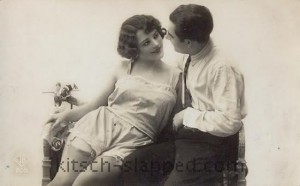 Feminism is all about a woman’s right to embrace her sexuality. That includes masturbation, hook-up sex, sex in relationships — any safe, sane, and consensual sexual act a woman wants. And without shame or regret. But feminism does not “celebrate” hook-ups, as if they were mandatory. Not for anyone, man or woman. And feminism certainly doesn’t expect women to suffer mediocre sex because that’s what men want.
Feminism is all about a woman’s right to embrace her sexuality. That includes masturbation, hook-up sex, sex in relationships — any safe, sane, and consensual sexual act a woman wants. And without shame or regret. But feminism does not “celebrate” hook-ups, as if they were mandatory. Not for anyone, man or woman. And feminism certainly doesn’t expect women to suffer mediocre sex because that’s what men want.
As Shanté Cosme writes in Why Sorority Girl Rebecca Martinson Writing About Double Blowjobs is Terrible for Ladies and Completely Our Fault, one should not confuse embracing one’s own sexuality with trying to please others — and in this case, we are talking about women trying to increase their value by trying to please men. Trying to please men in any capacity is not feminism.
Dance, Ballerina, Dance (Remembering Kathy Keeton; Gone To Soon & Forgotten Even Faster)
Have you heard about the big Bob Guccione auction that’s being held today?If you haven’t, get over there and look now! This post will be waiting for you when you get back.
Among the erotic offerings from the estate of Penthouse founder, there are Kathy Keeton items up for auction. Who was Kathy Keeton? For starters, Keeton was Guccione’s longtime girlfriend and eventual wife. But she ought to be remembered for far more than that.
Remembering Keeton just for her relationship with Guccione would be like simply dismissing Keeton for her beauty. True, Keeton, was beautiful; a ballerina who ended up on the burlesque stage stripping and with small parts in British B-movies, she was beautiful in face and form. But along with those attributes she was damned smart.
Kathy Keeton was one of the first women in magazine advertising sales. Sure, she was working for Penthouse; and that might upset a few women (then and now) who find all sexuality degrading to women. But at that time, there were few women in magazine publishing — other than Ms, of course. Keeton would help shape the future of Penthouse, especially the US edition, by directing the publication’s marketing efforts; she would co-found, write, and work for OMNI; run Viva: The International Magazine For Women; found a newsletter called Longevity which would become an international magazine; author books; as well as play a fundamental role in strategizing the long-term plans for the company, General Media Communications Inc., which published the magazines. Through it all, Ms. Keeton was noted for her leadership and advancement of women in publishing, including Anna Wintour (Vogue) and Nancy LeWinter (of Mode).
More than a magazine publisher, Keeton knew media in general and was among the first to see the potential of what we now call digital media. She was instrumental in Penthouse’s move to video and, later, the Internet. As early as 1992, Keeton was onto something that many publishers today are struggling to get:
She dreams of eventually putting her magazines on disks. “Niche magazines are the future,” Keeton says. On the high-tech side, she adds: “Knowledge is a key commodity now. Publishers are sitting on a gold mine of software.”
At the time of her death in 1997, 58 year-old Keeton was both president and chief operating officer of General Media Communications Inc. and vice chairman of the holding company that oversaw the publishing arm, General Media International. This was in addition to not only battling breast cancer but the National Cancer Institute (NCI) as well. (Keeton wouldn’t die from cancer, but rather from complications during intestinal obstruction surgery.)
Since Penthouse would beat Playboy in sales (and, subjectively, in other areas as well), it’s a shame that Guccione doesn’t have a bigger name than Heffner; but worse still is how so many have forgotten about Kathy Keeton. Even the official Guccione Collection website has little about her.
I hope to do more research & writing on Keeton; until then, here’s a quick list of her films: Carlton-Browne of the F.O. (Man in a Cocked Hat in the US, starring Peter Sellers, 1959), Expresso Bongo (1959), Too Hot to Handle (released in the United States as Playgirl After Dark, starring Jayne Mansfield, 1960), and The Spy Who Came in from the Cold (starring Richard Burton, 1965).
On This Day In History, We Ought To Be Reminded
On this date, November 6th, in 1967 a baby girl was born; just 21 years later, on July 18, 1989, she would be murdered.
The woman was Rebecca Schaeffer, an actress most famous for her role as Pam Dawber’s sister Patti Russell in the CBS sitcom My Sister Sam. For some of you youngsters, this might be before your time. (Perhaps all you know of Schaeffer is that she was the inspiration for the 2002 Jake Gyllenhaal film Moonlight Mile; the film is said to be loosely inspired by writer/director Brad Silberling, who was dating Rebecca Schaeffer at the time of her death.) But I remember distinctly being a young 24 year old woman and being shaken by the news of her death. Her age being so close — even younger than my own — pierced my youthful resistance to mortality; but what was worse was the way Schaeffer died.
Schaeffer was murdered by a stalker, a man who considered himself a fan — until God instructed him otherwise. This man-fan named Robert Bardo had adored Schaeffer’s youthful innocence, but disliked her new work as an actress when a small roll in Scenes from the Class Struggle in Beverly Hills put her in bed with a male character. “If she was a whore, God was going to appoint me to punish her,” Bardo said. His mission now was to “stop Schaeffer from forsaking her innocent childlike image for that of an adult fornicating screen whore.” Or at least that’s the story he would later tell after he stalked Schaeffer at her home, was rebuffed, and retaliated by shooting her to death.
Whatever motivated Schaeffer’s murderer, the fact is that her murder finally motivated the public to care about stalking. As is unfortunately the case in our celebrity-obsessed culture, it took the death of a celebrity like Schaeffer to generate awareness and concern. Such concern over Schaeffer’s death would even lead to protective legislation.
The majority of stalking, of course, occurs in the regular (non-celeb) world — and in the context of domestic violence or other situations involving everyday people the victims know. According to the National Center for Victims of Crime (NCVC) most recent fact sheet (August, 2012), the majority of stalking victims are stalked by someone they know, with 66% of female victims and 41% of male victims of stalking are stalked by a current or former intimate partner. When it comes to femicide:
* 76% of intimate partner femicide victims have been stalked by their intimate partner.
* 67% had been physically abused by their intimate partner
* 89% of femicide victims who had been physically assaulted had also been stalked in the 12 months before their murder
* 79% of abused femicide victims reported being stalked during the same period that they were abused.
* 54% of femicide victims reported stalking to police before they were killed by their stalkers
Now all 50 states, the District of Columbia, the U.S. Territories, and the Federal government recognize stalking as a crime; however well, or not well, police and other officials may respond, strides have been made.
Yet there is another huge unresolved issue that is brought to light with the murder of Rebecca Schaeffer: Rebecca was murdered with an illegally purchased handgun, but gun control has only gotten worse here in the USA — and by that I mean less gun control.
Since Rebecca Schaeffer’s death in 1989, her mother, Danna Schaeffer, has remained consistent in her concern, saying, “I’m angry at the system that allows things like this to happen, that allows a deranged person to get his hands on a deadly weapon.” Since then, Danna Schaeffer has lobbied and fought for sane gun control. In 1991, she went door-to-door at the Capitol lobbying for a ban on assault weapons and an end to the old gun show loophole on criminal background checks. She co-founded Oregonians Against Gun Violence (OAGV). And she continues to speak out today. But despite her actions and the actions of many, politicians still refuse to take necessary action to protect innocent Americans. What more we need? Why wasn’t Sandy Hook enough? Why has public demand for gun control waned? Do we need a celebrity massacre to make us give a damn?
Today, on the anniversary of Rebecca Schaeffer’s birth, let’s not only remember her, but do something. Contact your legislators and let them know that you demand stricter gun control laws. Now Is The Time.
The Way To A Man’s Heart Is Through His Stomach & Other Lessons In Vintage Cookbooks
This is the cover of The Way To His Heart “A Cookbook with a Personality”, 1941; note the figures on the cover.
The five female figures on the cover of this vintage cookbook depict the five cooks featured in the book itself. These five women are said to be three generations of one family. From the bottom left working our way to the top right are “Grandmother” Grace Toulouse Hunt, “Mother” Priscilla Wayne Sprague, “Newly Married Daughter” Dorothy Hunt Hales, “Collegiate Daughter” Jeanne Wayne Sprague, and “Teenage Daughter” Nancy Grace Sprague.
While I can admit to certain body changes in terms of aging, I find the rounding of age in proportion to hem length somewhat amusing… Not only is Grandma rather stout, but combined with her nearly floor-length dress she closely resembles a Russian nesting doll. And notice how only newly married Dorothy has curves in all the right places — illustrating her appropriate fertility status. (Heck, her proportions make me want to ask the new wife when she’s going to have a baby!) Perhaps even more amazing, this illustrated figure study of body image stereotypes is the artwork of one of these women; at least Dorothy “Dot” Hunt Hales is the artist credited. (More on that later.)
The story or “personality” behind this cookbook is that newlywed Dot writes home to her mother asking for some recipes. The occasion is the wonderful celebration of their 6 month wedding anniversary and the young bride has learned how important cooking and food is to her marriage:
I have discovered one important thing in the past six months — glamour and romance can be preserved in marriage if one’s husband is well-fed and comfortable.
Mother is, of course, no doubt delighted her daughter has seen the light and become a believer in the old adage that the way to a man’s heart is through his stomach. Not only is mom thrilled to help her wise and dutiful newly married daughter Dot, but mom enlists the help of Dot’s grandmother and sisters. These are their “letters” from the front of the vintage book:
And then, the most amazing thing happens! “One of the top men of Jack Sprat Foods, Inc., heard about it” and they decided to publish the cookbook! Enter Western Grocer Company, owner of the food brand, as publisher; enter the advertisements for Jack Sprat brand foods.
While the “homey, friendly” premise seems rather contrived to the jaded consumers of today (and the corporate ads themselves also draw into question Dot’s artwork), the book’s editor, Priscilla Wayne Sprague appears to be an actual author. But the proposed family relationships get a bit confusing…. My research continues and shall be reported soon. (Watch this space.)
I also have to share some information from the vintage cookbook’s section by college daughter Jeanne. Jeanne’s appearance certainly tones down any sex appeal, and we are likely to suppose any fears about daughters in college along with it. And even if such imagery might lend itself to jokes about college girl experimentation and stereotypical lesbian dress, the experimentation in the kitchen appears to have been limited — at least for sorority girls.
A College Girl (this one at least) doesn’t really cook at all — sororities provide cooks and sincerely hope they can keep the girls out of the kitchen. There are certain things, however, that the cook just isn’t in on, such as late Sunday sandwiches with you and your date — or rush teas and other occasions of state.
When the cook is out and the girls have free rein in the kitchen, here are some of the foods they can cook. All of these recipes are of the type that can be prepared quickly, cheaply and (for the benefit of the dates) charmingly.
Oh, how can poor Jeanne ever get her M.R.S. degree if she doesn’t cook?!
This vintage book from 1941 has some of the racism you might expect from the 1930s and 40s. At the bottom of the page, Jeanne starts a story which continues on the next page:
One of the girls at the sorority house is Irish — shanty Irish — we call her, because she has simple tastes — fried potatoes, baked beans and such. But one time I tasted the baked concoction she used to make and believe me there was nothing “shanty” about it — it was pure Park Avenue — here it is:
It is recipes like this one, based on canned goods, which certainly marks a change (if not decline) in cooking itself. This turning point in American history turns out to be a good thing for Jack Sprat Foods, Inc. and the Western Grocer Company. The grocery store addresses this issue in one of the advertisements for the Jack Sprat brand:
“Now, when I was a girl,” said Mom
“They used to joke about ‘cooks who were lost without can-openers.’ But it’s just a pleasant smile these days.”
“Why, Mom?” questioned Nancy, giving just the opening Mom wanted.
“Because now we get the very finest foods in cans — just take these Jack Sprat Peaches, for example.” Mom emphasized her point by holding a can at arm’s length.
“These are peaches at their very best — completely ripened on the tree, and canned quickly, to capture the fresh flavor and the precious vitamins all fresh fruits contain. No more sweating over a hot stove for me, when Jack Sprat will do the job for me so well!”
Of course Nancy agrees with Mom. What modern girl wouldn’t rather play tennis or swim on a summer afternoon, instead of helping can fruit in a sizzling kitchen?
Mom’s verdict applies not only to Jack Sprat Peaches, but to pears, apricots, pineapple, and an arm-long list of fine berries. You’ll find it pays to let Jack Sprat do your canning too.
If the convenience of modern canned foods was the advent of more free time for girls and women, perhaps it can be linked not only to the decline in cooking skills but to the decline in the “way to a man’s heart” adage. Men such as Barry Popik say this approach works for dogs and not men; however ironic the dog reference may seem to me, Popik seems to be saying this food-as-lure lore doesn’t work. Also, men at AskMen no longer find cooking on their top list of skills necessary in a female partner. Enlightenment reaches us, maybe? Would that such enlightenment about female body images would change as well.
Women & Children Should Be Scene & Not Heard
We’ve all heard the expression “Children should be seen and not heard”, an expression particularly aimed at girls. Well, apparently it was updated in the 1970s to be “Children should be scene and not heard”. Enter Exhibit A, a vintage advertisement for Mary Maxim needlecraft kits which features a little girl dressed to complete a festive holiday scene:
The girl wears a floor-length red dress, much like the table wears a red floor-length tablecloth. Both decorative small female child and small table each wear overlays of fancy white crocheted creations (the Mary Maxim pinafore and tablecloth kits). If anyone can show me an example of this done to boys or men, please do.
The ad was found in the September 1978 issue of Decorating & Craft Ideas Magazine.
A Geriatric Problem: Vintage Advertising For Little Blue Pills
A vintage advertising blotter, likely from the 1930s — 1940s, which focuses on a male geriatric problem.
The blotter reads as follows — and it should be noted that the print gets smaller as it goes along (which is cruel in many ways for an aging male, I say):
A GERIATRIC PROBLEM
One of the problems of middle age is loss of sexual power in men who are still capable of raising a family. In such cases and effective aphrodisiac may be indicated.
POTENT APHRODISIAC
XANTHINUX (Cole) stimulates masculine potency through the spinal cord, just as a strong cup of coffee stimulates the thinking centers of the brain. The result is a firmer, more vigorous erection and orgasm.
Reports from various physicians show that XANTHINUX not only boosts male potency but also has a euphoric action.
Because of its strong aphrodisiac action, XANTHINUX is not recommended in cases where sexual intercourse should be curtailed; elderly men with severe cardiac conditions or arteriosclerosis.
Samples & Professional Literature on Request.
From the Cole Chemical Co., St. Louis 8, MO. U.S.A. [Printed in U.S.A. (form) 549.]
Further research shows that Xanthinux was a combination of strychnine (yikes!), caffeine, and theophylline. Big shocker here: in 1963, medical reports on Xanthinux state that there’s “no evidence that it acts as a sexual tonic.”
Plus there’s that whole strychnine-poison thing.
However, culturally speaking, I do find the reference to “men who are still capable of raising a family” a line that’s absolutely missing in today’s recreational & romantic messaging about ED. Which, naturally, speaks extra loudly in today’s world of restricted women’s rights.
See also this vintage pharmaceutical advertising blotter for women.
Women’s Yellow Pages
Women’s Yellow Pages of Greater Milwaukee, 1995-1996. (Please refrain from jokes about “fingers doing the walking” among the women of Milwaukee. Thank you.)
Today, Yellow Pages & phone books in general seem so quaint…. And women themselves today? Not exactly “quaint”, but certainly undervalued. So I was amazed to find out that such Women’s Yellow Pages still exist in some areas.
Related: My article at Collectors Quest regarding the history of telephone books.
“Embroidered ‘Japs’ Amuse the Little Folks”
The following comes from the September 1916 issue of Home Needlework magazine. While the embroideries are lovely, the fashionable craze for Orientalism at that time certainly had more than its share of racism.
Discussing What’s Going On In These Antique Photographs
See on www.facebook.com
Feminist Porn Depicts Sexuality’s Unruly Side Too
As this type of porn gains visibility, it reflects a greater demand for explicit sexual representations among women, where sex isn’t always a “ribbon-tied box of happiness and joy,” say editors in this excerpt from “The Feminist Porn Book.”
…With the emergence of new technologies that allow more people than ever to both create and consume pornography, the moral panic-driven fears of porn are ratcheted up once again. Society’s dread of women who own their desire, and use it in ways that confound expectations of proper female sexuality, persists. As Gayle Rubin shows, “Modern Western societies appraise sex acts according to a hierarchical system of sexual value.” Rubin maps this system as one where “the charmed circle” is perpetually threatened by the “outer limits,” or those who fall out of the bounds of the acceptable.
On the bottom of this hierarchy are sexual acts and identities outside heterosexuality, marriage, monogamy and reproduction. She argues that this hierarchy exists so as to justify the privileging of normative and constricted sexualities and the denigration and punishment of the “sexual rabble.”
See on womensenews.org
Ultraviolet | This has to stop
Teens in Steubenville had no idea it was rape. Yale thinks a written reprimand is a good enough punishment for “nonconsensual sex.” There’s an epidemic in this country, and RAPE CONFUSION HAS TO STOP.
See on act.weareultraviolet.org
Brilliant Comic Highlights the Complexity of Speaking Out About Sexual Assault
Trigger Warning: This post mentions sexual violence, reactions to sexual violence, and victim blaming.
Speaking of sexism and comics, this simple 3 panel webcomic tweeted today by @GirlhoodStudies is alllll kinds of genius. It juxtaposes the kinds of reactions people have to hearing about sexual harrassment and, in doing so, shows the viewer how friggin’ hard to is to talk about sexual violence in a meaningful way – as if we didn’t know that already.
See on www.bust.com
Cranmer: Should Christians be feminists?
Last week the delightful Vicky Beeching tweeted something about receiving abuse for having the audacity to advocate a feminist theological stance. His Grace pitched in, asking: “Who are these infallible zealots declaring that one may not be both feminist and Christian? Do they have idea of the meaning of either term?” This brought further censure and derision upon his own head. Perhaps a little clarification is required…
Hypocrisy, Hate and Harm #no2h8splc
[This] is what happened when a bunch of RadFems righteously took over the offices of the Ladie’s Home Journal because it was a vector for promoting false stereotypes about women. Protesting negative stereotypes of cisgender women in the media has a long and proud tradition among feminists.
See on www.transadvocate.com
In Lilli Vincenz’s papers, a trove of gay rights history
History is written by the victors, but also by the scrapbookers, the collectors, the keepers, the pack rats. By those who show up, at the beginnings of things and with the right technology. History sometimes comes in pieces. It needs to be reassembled. Pasted and coaxed. Sometimes the finished product still has holes.
In one corner of the climate-controlled manuscript division, on a series of otherwise empty shelves, sits Lilli Vincenz’s unprocessed collection. …
Twelve boxes. Cream-colored. Heavy. Inside: meticulous fragments of the gay rights movement of the latter half of the 20th century. Political pamphlets, sociological surveys, photographs and obituaries. Diaries of a young woman who was nervous about going into her first gay bar but whose Arlington living room later became the default place for gay women to feel at home.
See on www.washingtonpost.com
Looking Back At Vikki “The Back” Dougan (A Biography)
Collecting vintage smut, as I do, I know who Vikki Dougan is; but I’ve been surprised a number of times by both the lack of recognition this iconic beauty has and the lack of information about her. So, ever obsessed as usual, I set out to correct the situation.
Vikki Dougan: you may not recognize her from the front, but you likely recognize her backside — hence her nickname, “The Back”.
In Persistent Pop (July 21, 1974), John Russel writes of how inspirational images of Vikki Dougan were to English pop artists:
A particular prominence was assigned, for instance, to ads which featured a young actress named Vikki Dougan. In memoirs of the period, individual ads featuring Miss Dougan are traced from house to house in ways that recall the hunt for a respectable provenance which plays so large a part in the authentication of Old Master paintings. Of an Esquire photograph of Miss Dougan, Richard Hamilton remembers: “I first saw it decorating a wall in [Alison and Peter] Smithson’s home. I gained my own copy from a student’s pinboard in the interior-design department of the Royal College of Art. Lawrence Alloway gave me the data on her; the photograph had impressed him sufficiently to make him regard it as a file-worthy document. It turned up again recently as one of a group of pin-ups in a painting by Peter Phillips.”
Her images were not only collected by English pop artists, but even inspired works, such as Richard Hamilton’s $he (1958-61).
This biography attempts to fill in some of the blanks about Vikki Dougan.
Before she earned the notorious nickname (and a plethora of puns), Vikki Dougan was born Edith Tooker in New York in 1929, to her parents Wilber and Mary (nee Dougan) Tooker. Legend says that in 1946, at the age of 16, she becomes both a Miss Rheingold finalist (but is disqualified for being underage) and the wife of a William Symons, the owner of a local photo studio.
Vikki’s big break came in 1948, when she (as Vikki Stappers Dougan) won the eighth annual New York Skate Queen competition. In promoting the ninth annual event, the following was mentioned in Billboard (April 2, 1949):
The purpose of the event, a joint promotion of Empire and The New York Journal-American, is to select an ideal girl roller skater and glorify her for a year. Judging will be based on charm, beauty and personality, with no points whatsoever for skating skill. Contestants must only appear on skates. …Professional skaters models and actresses are banned.
(Vikki, as Queen, and finalists followed up in 1949 by heading the “first ever” fashion show, sponsored by the Roller Skating Institute of America (RISA), in which they modeled “30 attractive rink costumes, loaned for he occasion by the Lence Company,” according to Billboard, March 1949.)
Winning the 1948 skating title would launch Vikki’s pretty face and figure into work as a model — and into gossip Walter Winchell‘s gossip columns, linked to DJ Art Ford. Note that in this 1948 “Look Pink” ad for cosmetic company Cutex, she is even credited — but as Vikkie Dougan, “New York model and prize-winning skater”.
In 1949, Vikki Dougan the “’48 Beauty Queen of Figure Skating” is featured in a comic-strip-style ad for Camels cigarettes, meeting Betty Lytle, one of America’s top-ranking women’s roller skaters. (Skates would be sold with Lytle’s name.) This appears to be the last mention of Vikki Dougan the skater; probably to great relief of Lytle, Dougan, and everyone else.
All this attention unsettles her husband, Bill Symons. At some point after their daughter Debbie is born in 1950, he is said to have walked-out on their marriage. Dougan gets a divorce in Mexico and (per Winchell’s column in February of 1952) Vikki establishes residency in Florida while working as a cover girl at Ciro’s, in Miami Beach. Also about this time, she is signed to agent Louis Shurr.
In the October 26, 1953, issue of Life, Dougan appears not only on the cover, but in the feature article Careers Aplenty: Vikki Dougan models, acts, designs, mothers. In this article, Vikki is listed as 21 years old and is accompanied in the photographs by her three year old daughter, Debbie. The Life article lists Vikki as having started in modeling at age 13 (as Deirdre Tooker), studied at Betty Cashman studio, and appeared weekly in Jackie Gleason’s TV show — along with the clothes designing, mothering, etc. Life also mentions that Vikki “once caused a stir in fashion circles by using wigs to change her appearance and help her get more modeling jobs” — something also featured in Life (July 28, 1952).
March 29, 1954, Dorothy Kilgallen mentions Vikki Dougan in her column:
Vikkie Dougan, the pretty blond model who made such a hit with Frank Sinatra in Florida recently returned to New York to discover that thieves had cleaned out her apartment. They took her dresses, jewelry, mink coat… and black wig!
May 28, 1954, there are the gossip reports that Vikki, “the young model, who made the cover of Life recently” had posed as Miss General Electric earlier that day.
Dougan continues to model (including the 1955 Flexees lingerie ad and on the cover of the George Shearing Quintet’s Velvet Carpet LP), be seen on Gleason’s show — and be mentioned in the gossip columns. In 1956, it was rumored that Gordie Hormel asked her to marry him. She appears as a show girl in Back From Eternity. On April 27, 1956, Winchell On Broadyway reports that Vikki Dugan, “the ‘Away We Go’ gal with the Jackie Gleason show”, signed with MGM. Or did she? On December 21, 1956, Dorothy Kilgallen reports that Dougan “is the first girl to be signed to a Batjac (John Wayne) contract since Anita Ekberg was given her big opportunity.”
In January of 1957, there are reports that Dougan has a role in The Great Man. (She would play Marcia, the new receptionist.)
March 29, 1957, Erskine Johnson‘s Hollywood Today column is titled Vikki Dougan Reverses Trend And Backs Into Film Career:
February 13, 1957, Hedda Hopper reveals that she, Louells Parons, and Hub Keavy are to “pick Miss 8 Ball of 1957. The choice has narrowed to Venita Steenson, Carolyn Jones, Vikki Dougan, Kipp Hamilton, and Adrienne Alison, all beauties. But we’ve go to decide on one, O, dear.” Vikki Is New Ca-rear Girl In Hollywood, by Lee Belser, is so full of puns that they couldn’t publish this on April Fool’s Day and instead published it on April 2, 1957.
Through this time, Vikki “The Back” Dougan makes the rounds in men’s mags, including pictorials in the April 1957 issue of Nugget.
May 7, 1957: Hollywood gossip columnist Harrison Carroll reports that Vikki has been made queen of the California Chiropractic Association’s “Perfect Posture Week.”
In Clothes Make The Act — And The Actor (Oakland Tribune, May 19, 1957), Lloyd Shearer writes a piece that seems to be tailor made for getting The Back out of negative press. In his article, Shearer begins by discussing this “new trend in show business” whereby talent draws on fashion and “practically any female “name” can earn “5,000 a week and up if her attire clicks with the press.” The piece appropriately finishes with Vikki Dougan & her dresses, stating that it was Milton Weiss (Hollywood publicist who’d worked with Anita Ekberg) who was, umm, behind Dougan’s look.
His first move was to have three expensive dresses made for her — without backs. He then titled his client “The Back” and had her appear at previews and parties in her plunging creations. Soon local photographers zeroed in on Miss Dougan’s bare spinal column, and gagsters began originating such cracks as, “Vikki Dougan makes the best exits in town.”
Finally Vikki was banned from someone else’s preview party because her backless formal was drawing too much attention. The incident received proper press coverage. Today Vikkie — born Edith Tooker in Brooklyn — is riding toward fame on the strength of her clothes, what there is of them. It’s a trend, all right.
You might not want to put too much stock in that story tho; it changes, as you’ll soon see.
However, Dougan’s back does make a splash, landing her tail in the June 1957 (Vol. 4, Issue 6) of Playboy.
As noted in that issue of Playboy, the photo that really started it all was a wirephoto which came from Dougan’s appearance at the Hollywood Foreign Press Association’s 1957 awards banquet. On July 10th of that year (some Old Guard Hollywood retaliation, perhaps?) Mike Connolly reported in his column, “New Hollywood game called True Or False: Guessing whether Vikkie Dougan got her idea for backless dresses from watching and old Marlon Brando movie…” (In reference to Sophia Loren in A Countess from Hong Kong.)
The Playboy feature was followed-up quickly by a pictorial in Esquire (August 1957).
Around this time The Limeliters would record a song by Cal Grigsby (pseudonym for Malvina Reynolds and Lou Gottlieb) entitled Vikki Dougan, in which they sing of Vikki’s “callipygian cleft” and beg her to “turn your back on me”.
These photographs (undated, circa 1950s) taken by Life staff photographer Ralph Crane capture America’s love-hate with Vikki Dougan & her notorious backside.
In October of that year, press for Hollywood Queens Of Tomorrow, including an AP photo — in which Vikki is not shown from the back:
Fifteen young actresses for whom stardom is predicted wait to go on stage in Hollywood Friday at the fifth annual Deb Star Ball, sponsored by the Hollywood Make-up and Hair Stylists. Several thousand movie people were in the audience at the Palladium. Left to right: Joan Blackman, Peggy Connolly, Patricia Craig, Vikki Ddougan, Dolores Hart, Diane Jergens, Barbara Lang, Ruta Lee, Jana Lund, Carol Lynley, Erin O’Brien, Joan Tabor, Joyce Taylor, Rebecca Welles and Gloria Winters.
Ten days later, Vikki Backs In, Helps Maxie Promote Ice Cream Breakfast (by George Flowers, Independent-Press-Telegram, October 20, 1957).
On the 21st of that month, Vikki the starlet appears at the annual Publicists’ Association Ballyhoo Ball. This is the famed party where Greta Thyssen had a cheetah on a leash, Joan Bradshaw brought a lion, and Errol Flynn and Maura FitzGibbons were arrested on drunk charges; Vikki “Lady Godiva” Dougan was on an artificial horse.
The November 1957 issue of Modern Man carries photos of Dougan (by David Sutton).
December 22, 1957, Dougan uses giant scissors for the ribbon-cutting opening of a Safeway Market in Tarzana.
In 1958, Dougan attempts to change her image. It is noted; but still does not please. On March 24, 1958, Harrison Carroll accuses Dougan of wearing “a shapeless sack (looked like a nightgown) over a satin sheath.” On March 27, 1958, Vikki Dougan was reported to be at the Oscar Award Ceremonies — but still not pleasing anyone:
A bizarre note was added by eager starlet Vikki Dougan, who arrived in gaudy makeup and flapper costume.
Poor Vikki can’t win!
In his June 2, 1958, column, Earl Wilson asked Vikki “about the alleged practice of Hollywood gals calling guys for dates.”
“No, but suppose you’re going with an actor and you say after a premiere, ‘I’d like to go to Mocambo’ and he says, ‘But I can’t afford it.’ So you say, ‘I don’t want to embarrass you but couldn’t we go it I paid the bills?'”
It happened to her, she said, “and strangely enough, if men accept it, they resent it.” Vikki said she may be a sexbomb in the papers but she’s had three dates in a year. “The men you go with want to get married,” she added. “The trouble is, they never say when.”
Meanwhile, photos of her continue to circulate in the various men’s mags.
May 23, 1959, Harrison Carroll uncovers Dougan professional and relationship news.
If she listened to Lili St. Cyr‘s estranged husband, Ted Jordan, actress Vikki Dougan soon will be displaying even more epidermis than in those backless gowns that used to make Hollywood night clubbers gasp.
Jordan, who just started to date Vikki, tells me she would be great in a genteel strip act.
“She reminds me so much of Lili,” he says. “They have the same nose and mouth, the same beautifully arched back. Vikki is not quite as tall as Lili, but, otherwise, their measurements are about the same.
“And I heard Vikki sing. She’d really do great in night club work. I know the ropes and I could help her.”
I checked with Vikki. She’s not convinced, but she’s listening.
Despite roles in three other films (The Tunnel of Love, The Rebel Set, and Here Come the Jets), Vikki’s career clearly wasn’t moving forward enough. (As if the helpful offers from Jordan didn’t tell you that!)
The backslide was noticed.
In October of 1959, “Remember Vikki Dougan?” is the headline. Not only has she fallen out of the press, but apparently work of any kind. She, and her nine year-old daughter, have been living off a $40 weekly unemployment check for the past eight months.
A similar article runs in November of that year, in which Dougan says the reason she wore a backless dress in the first place was to avoid posing “in bikinis and other cheesecake.”
The ever-helpful Erskine Johnson’s got Dougan’s back again at the tail-end of January of 1960, allowing the actress to spin more tales about her notorious backside.
February 22, 1960, Vikki Dougan (misspelled “Vicki Dougan” in the photo caption) is one of the judges for the Miss Pasadena Contest.
But then crickets chirp and Dougan disappears until August 28, 1960. Then photos of Vikki and former Texas Christian football player tuned actor, Jim Sweeney, appear over the AP and are widely picked up — primarily because he places the diamond engagement ring (along with a friendship ring) on the toe of her left foot. Days later, on September 3rd, she (as Edythe A. Tooker) marries James R. Sweeney; he’s 25, she’s 24.
The Pacific Stars & Stripes reports that “Vikki Apparently Needs No Direction” on the set of Peter Gunn (The Candidate episode). (September 16, 1960; photo of Dougan with caption about her appearance on Peter Gunn from San Antonio Light, October 23, 1960.)
Dougan appears in episodes of Michael Shayne (Murder Is a Fine Art) and Sea Hunt (Amigo) in March of 1961. But it’s rather silent, again, until November 20, 1961, when promo photos and pun-y lines about Dougan doing the twist at New York’s Peppermint Lounge appear.
On November 26, 1961, Walter Winchel reports that Vikki had “told chums she will sue Leo Guild for including her in his soon-due book Hollywood Screwballs which mentions Oscar Levant, Bing Crosby, F. Sinatra, and Jayne Mansfield, who aren’t suing.”
Earl Wilson’s December 1, 1961, column mentions that Vikki Dougan has “posed in a nightie on the subway for the cover of Subways Are For Sleeping.” (A Percy Faith LP.)
September 9, 1962, columnist Connolly quips, “Vikki Dougan, who used to pose in backless gowns, is slamming out a slim volume of verses to be titled “Purple Mud.” Vikki tells me it will be a backless book.” (If anyone show me a copy — or even prove it wasn’t just a joke, please do!)
Vikki appears once again in Playboy; this time the December 1962 issue, in “Playboy’s Other Girlfriends”. (She would also reappear in the January 1989 issue in “Women Of The Fifties”.)
January 18, 1963 Vikki appears in Los Angeles court to divorce Sweeney, claiming he deserted her after going through her $10,000 savings. The divorce is granted and she accepts a $1 per month alimony.
On June 3, 1963, Earl Wilson reports that Vikki plans to open up a Hollywood barbershop for men.
“Remember Vikki Dougan, Hollywood’s gift to the world of backless dresses? She just signed for a feature role in Hootenanny at MGM,” reports Connolly on July 22, 1963. (She did appear in 1963’s Hootenanny Hoot.) But that didn’t pay the bills; August 11, 1963, Wilson says, “Backless Vikki Dougan now works for a cosmetic company.”
In its January 1964 issue, Cavalier runs a “The Back Is Back” pictorial which features 12 nude photos of Vikki Dougan. Dougan initiates a lawsuit against publisher Fawcett, stating that she posed nude for photos for Playboy, but later backed-out, and they did not have her permission to publish them.
There are a few scattered gossip “spottings,” but nothing much of note until February 22, 1967, when Harrison Carroll reports:
Despite the fact that she took along four wigs, my scouts spotted actress Vikki Dougan at a Houston prizefight with famed attorney Melvin Belli. And they looked just as affectionate as they did recently at Scandia. Can’t blame Melvin. Vikki is a beauty. Understand the two also were in Chicago together and visited Hugh Hefner.
Also in 1967, she would appear in Hotel. And there were reports Dougan, along Sugar Ray Robinson, was part of the cast of Tony Randall & Mickey Rooney’s Las Vegas rendition of The Odd Couple at Casear’s Palace.
In November of 1969, the Fawcett/Cavalier lawsuit is settled out of court. Vikki says the magazine paid her $75,000 to settle; Fawcett Publications, Inc., says it didn’t pay that much.
March 21, 1974, Earl Wilson’s It Happened Last Night column focused on “Shutterbug Respect” and mentions that Vikki Dougan (still haunted by her notorious back-side views) “has joined the profession.” (The profession of photographers, that is.)
And after that, Vikki Dougan seems lost — save for those who fell in love with her image. Along with inspiring pop art, Vikki and her sexy back would be the inspiration for Jessica Rabbit.
Here’s a 2009 interview with Dougan, in which she dishes about Jessica Rabbit and Sinatra:
I’d love to know more, so, if you know something — if you know Vikki! — please do share.
Gloria Steinem – Pop Art Protests
As one of the leading American feminists since the early 1960s Gloria Steinem has had a long, varied and controversial career as a writer and political activist that has seen her employed as an ‘undercover’ Playboy bunny, lobby as a pro-abortion…
See on www.voicesofeastanglia.com
Sonia Delaunay : Textile Artist
When reading about the history of fiber art it seems to take on many elements. The history of fiber art incorporates craft, textile and design elements that are not usually explored in regular art history. The use of embroidery and clothing inspired artists such as Sonia Delaunay who had started off as a painter and found new inspirations when she shifted her medium from brush, canvas and oil paint to needle, thread and textile printing. In exploring Sonia’s textile and wearable art works I’d like to explore her success as a woman in the art world.
Suzy Favor Hamilton Shouldn’t Be Shamed For Turning to Sex Work
In 1983, the Big Ten Conference established a women’s Athlete of the Year award and later named it after Suzy Favor Hamilton, a University of Wisconsin middle distance runner and alumna who followed her illustrious college career with three appearances in the Olympic Games. She was more than qualified to have her name attached to such a prestigious award. Unfortunately, the conference announced on Tuesday that her name would be removed from the award after it was revealed in December that Favor Hamilton had worked as an escort since 2011.
“I do not expect people to understand,” she wrote on Twitter, “but the reasons for doing this made sense to me at the time and were very much related to depression.” She added that her husband knew about her work and didn’t approve of it.
But something that the Big Ten needs to realize — along with the rest of the country — is that sex work is one of the most stigmatized professions in the world.
See on www.policymic.com
Margaret Cho’s Laughing Orgasms
This is kind of fun: in the most recent installment of Hysterical Literature, Margaret Cho keeps breaking out in squirming giggles and laughter as she orgasms — and eventually drops her Kindle — while reading aloud at the table…
See on www.erosblog.com
